Slave to the Game
Online Gaming Community
ALL WORLD WARS
PHOTO INTERPRETER'S GUIDE TO JAPANESE MILITARY INSTALLATIONS
1945.
PART II.
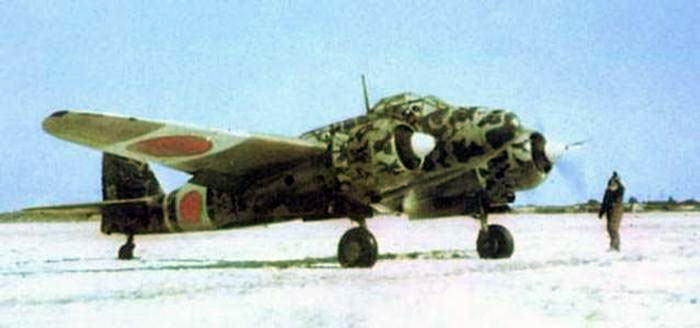
MILITARY INTELLIGENCE DIVISION
1 SEPTEMBER 1945
WAR DEPARTMENT
WASHINGTON, D.C.
SECTION XI. ARTILLERY
The detection of hostile artillery positions from photographs is one of the most frequent duties of an Army interpreter. In this type ot work it is most important that other sources of information, such as sound ranging and flash spotting, be used in conjunction with aerial photographs.
FIELD ARTILLERY BATTERIES
Artillery interpretation is the best example of interpretation by associated features. On medium- and small-scale photographs, the guns will often not be visible, and it is necessary to look for certain characteristics which develop when a battery is in action. It is seldom that more than one or two of these characteristics will occur in the same artillery position, and the following list is given only as an aid to detection.
1. Tracks-—These appear around the guns and in line behind the guns, where the personnel of the battery pass to and fro; also they may be seen leading from the guns to the command post and to farmhouses and dugouts where the battery personnel may be accommodated. Later the tracks made by the ammunition trains may begin to show, and a turning circuit probably will be seen.
2. Regular layout-—The usual fire unit is a four-gun battery- The line of guns, although not aiways a straight line, must be approximately straight to give a wide field of fire to all guns, and will be at right angles to the probable line of fire- Equal intervals between guns will often betray a battery.
3. Cable trenches or overhead cables-—If a position is likely to be occupied for any considerable length of time, cables will either be buried or carried on poles. In either case, they will serve as a pointer to a battery position.
4. Emplacements.—If a battery is dug in, gun pits are comparatively easy to see because of ^elr regular shape and the disturbed earth, camoufiage may be erected over the whole position or separately over each gun- If a battery comes into position in the open, shelter trenches often be dug for personnel, and each gun probably have a dugout and ammunition pits, which may give useful information on an otherwise concealed position.
5. Blast marks.—These are formed on the ground by the continual firing of guns from the same position. They appear as light gray or whitish fan-shaped marks in front of the muzzle of the guns; except in snow, when they appear as black smudges. In dry weather, they remain visible for some time after a position has been evacuated, so they are not definite evidence of the activity of a battery.
6. Alternate and dummy positions.—While alternate positions will probably be concealed as carefully as the original positions, dummy emplacements are sited to draw fire and therefore will be visible and obvious. Absence of tracks and other associated features may reveal that a position is a dummy, and the presence of the dummy often will point to a genuine battery in the area.
7. Types of artillery.—Light guns are field pieces ranging in size from 40-mm antiaircraft and antitank guns to 105-mm guns. Medium caliber guns are over 105-mm and as large as 155-mm, while heavy caliber guns are over 155-mm. Many positions will be camouflaged, and an estimate of the caliber of weapons identified in a photograph must be made from the size and amount of camouflage and from proximity to our own forward lines and artillery positions. Interval between guns will also vary with their caliber.
MEDIUM AND HEAVY ARTILLERY BATTERIES
The indications described in the preceding paragraphs about field batteries apply equally to medium and heavy artillery, but because the latter are less mobile than field artillery, tracks and other associated features may be in evidence sooner, even in mobile operations. Also, emplacements for this tvpe of artillery are more necessary than for field batteries. Gun platforms frequently must be dug in before the battery can open fire. A number of tracks leading from a railway to a wooded area may indicate the presence of a medium or heavy artillery battery in the woods.
A STUDY OF THE LIFE OF A BATTERY

A heavy battery has been selected as an example to show how dally study of a position will present an accurate interpretation. The locality, although consisting of broken ground, is served by a fairly good road. This small-scale photograph aitd earlier ones reveal no enemy activity.

Later, photographs reveal the area is very active. Three aketchily camouflaged objects about the size of heavy guns (1, 2, and 3) can be distinguished as well as a number of tractor and vehicles. Very dose inspection reveals wheel tracks. The battery has not been laid out, and No. 2 gun has not been sited.
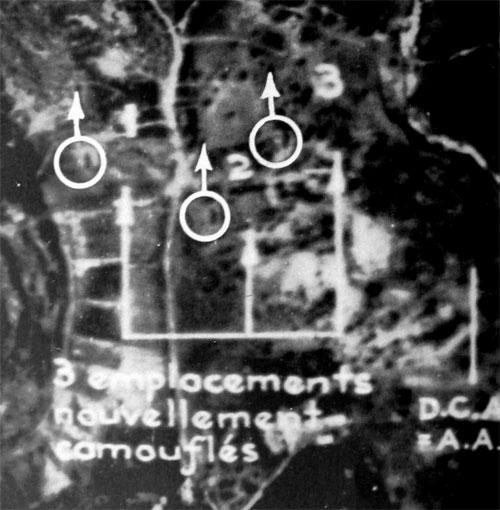
Still later, on photographs with very poor definition, the three gum appear to be parade! and emploced.
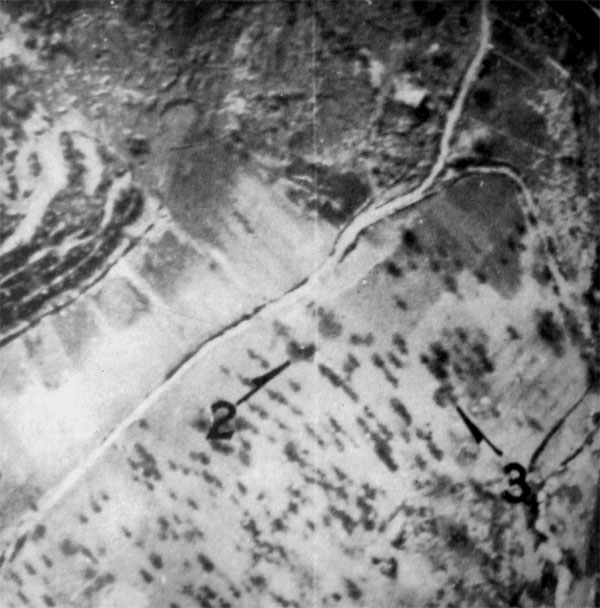
This photograph reveals that the camouflage of the position Is well
advanced. No. 3 gun can still be seen. The existence of No. 2 gun
can be guessed, but No. 1 is completely invisible.
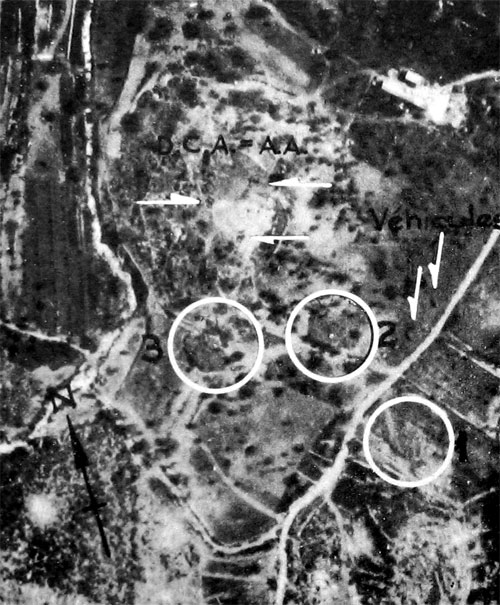
Photographic cover of better definition shows that the three-gun battery is completely camouflaged. The three light antiaircraft emplacements indicate that the position is still occupied.

Less clearly defined photographs of a later date are even more difficult to interpret. The camouflage appears perfect. The occupied light antiaircraft emplacements show the position is unlikely to have been abandoned. However, in these photographs the position was interpreted as unoccupied.
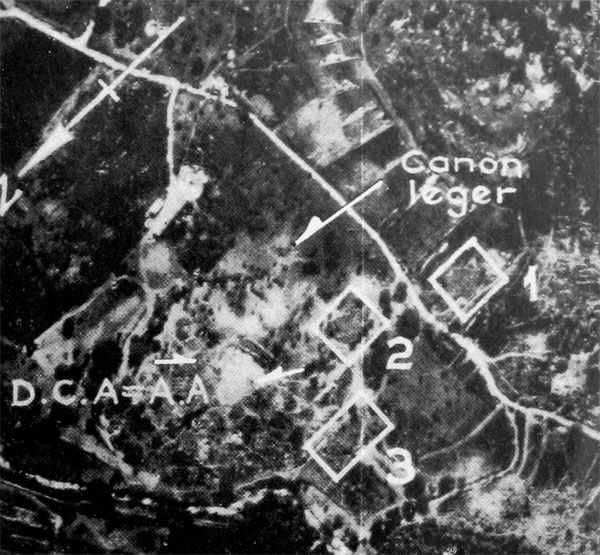
Here the situation is exactly the same. The light antiaircraft guns have not been removed.

Although these photographs are of slightly better quality, it is impossible to tell whether the position is occupied. This example demonstrates the difficulties which camouflage creates for the interpreter. Comparative study of the area with reference to other sources of information, such as sound and flash ranging and shelling reports, will determine if the area pin-pointed is active. It can then be attacked by counterbattery fire.
Note: This battery was not heavily engaged by our atillery, but was bombed from the air. A ground check revealed the emplacements were circular, 30 to 40 feet in diameter. The ammunition left behind was 17 cm.
COMPARATIVE STUDY

Scale 1:8,500. Before the position was occupied
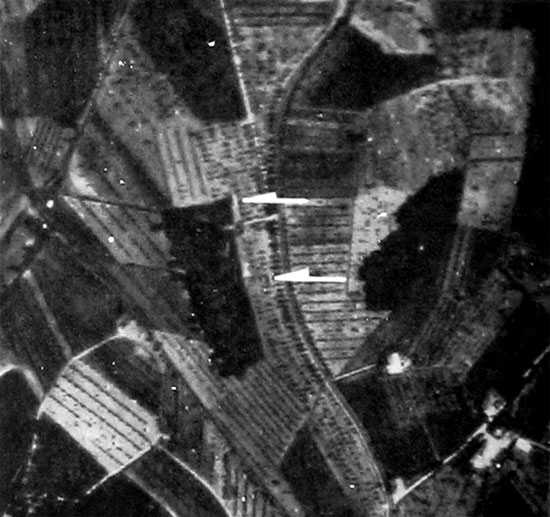
Scale 1:12,500. Interpretation: two 170-mm guns.

Scale 1:8,500. Before the position was occupied.
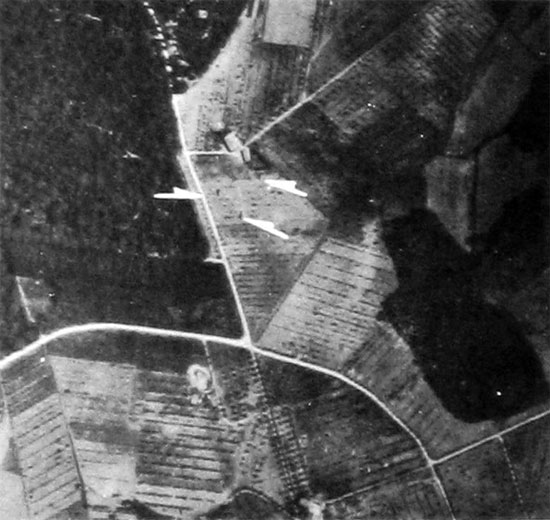
Scale 1:13,000. Interpretation: three 150-mm gun.
The following are examples of the time element involved in two incidents; both positions were pin-pointed on the same sortie.

Before the position was occupied.

Scale 1:8,300. Interpretation, three, probably four, 150-mm guns. Photographs taken at 0915. Prints were available at 1430. Interpretation completed at 1600. Message sent to artillery section at 1630. Photos handed to Piper Cub pilot at 1800.

A battery of our 155-mm guns moved in during the night and photographs taken the next day show that the guns have withdrawn after shelling.
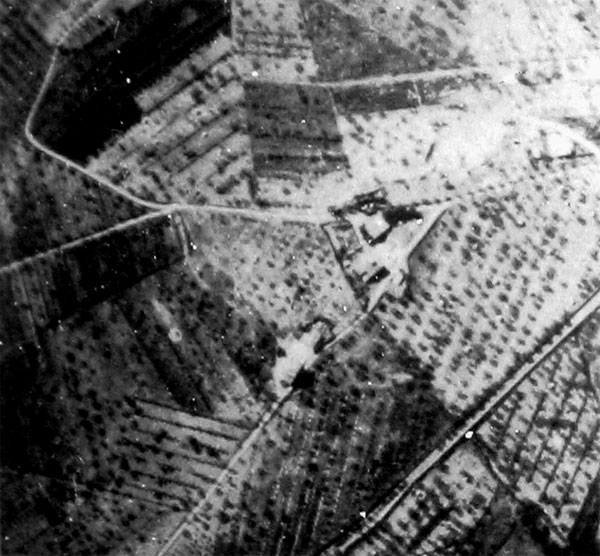
Before the position was occupied.
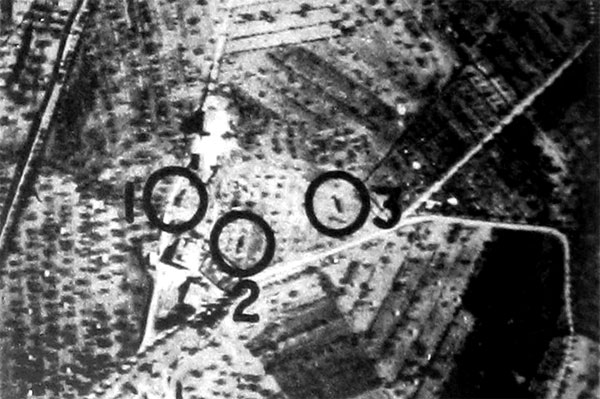
Scale 1:8,300. Interpretation: three 170-mm guns.

Scale 1:13,000. Photographs taken after shelling show one gun withdrawn, while the two that remain in position appear to be damaged.
An example of a study of the road net in the artillery zone

It was noted on photographs that a very narrow bend in the road was, because of the terrain, the only through route. This vulnerable point was given to the artillery at a target. On later photographs it was ihown that the road was blocked by vehicles.

Ground check and photographs taken on the spot testify to the accuracy of the shooting. (1)
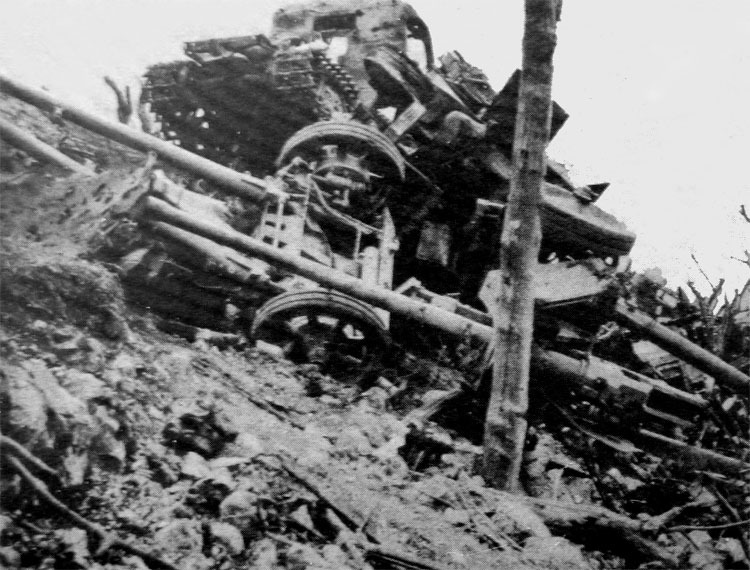
Ground check and photographs taken on the spot testify to the accuracy of the shooting. (2)

Ground check and photographs taken on the spot testify to the accuracy of the shooting. (3)
EMPLOYMENT OF TACTICAL RECONNAISSANCE
Good liaison between the photographic sections and the tactical reconnaissance squadrons will enable the interpreter to obtain rapid cover of suspected gun areas at a scale better than that possible on high altitude sorties, and in addition these photographs will assist the interpreter in answering many other queries confronting him.
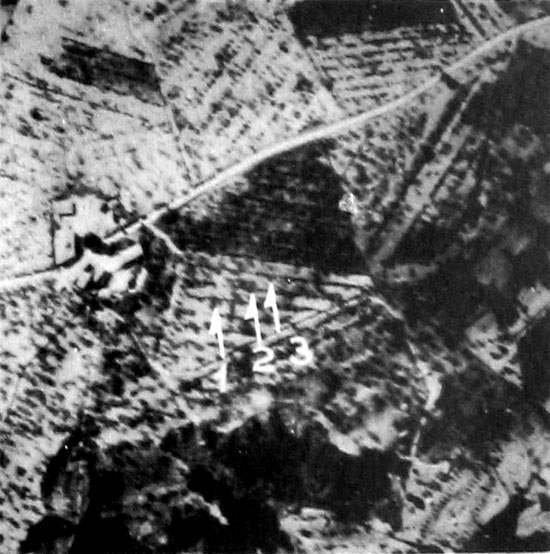
Scale 1:8,500. Guns had been reported in this area, but because of the scale of the photographs and good camouflage the interpreter could not pin-point the gun emplacements.
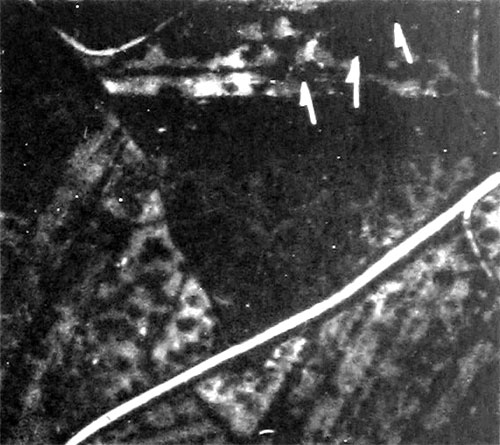
Tactical reconnaissance was informed, ond several hours later photographs of the objective, taken at what was believed to be a sufficiently large scale, made it possible to pin-point a three-gun battery.
LESSONS ON THE INTERPRETATION OF FIELD GUNS
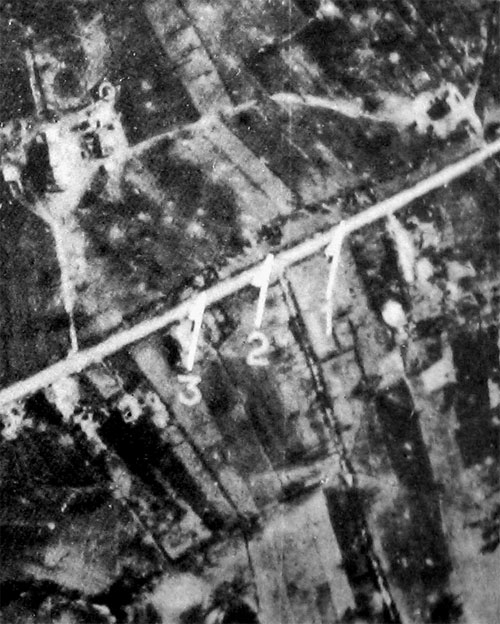
Three field guns in a well-defined emplacement. The very clear photographs, at a scale of approximately 1:7,000, reveal all the details of the position.

Interpreted as three small guns, type unknown. They are clearly visible in circular emplacements. A shelter has been dug near the No. 3 gun.
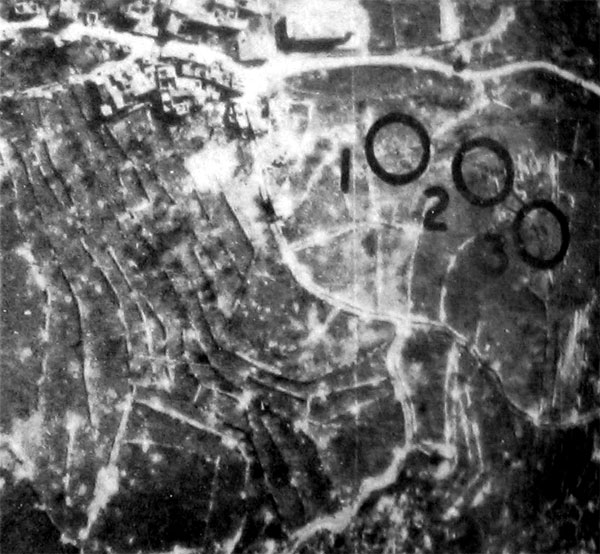
This position was interpreted as three field two certain, one probable. No. 2 is fairly clear.
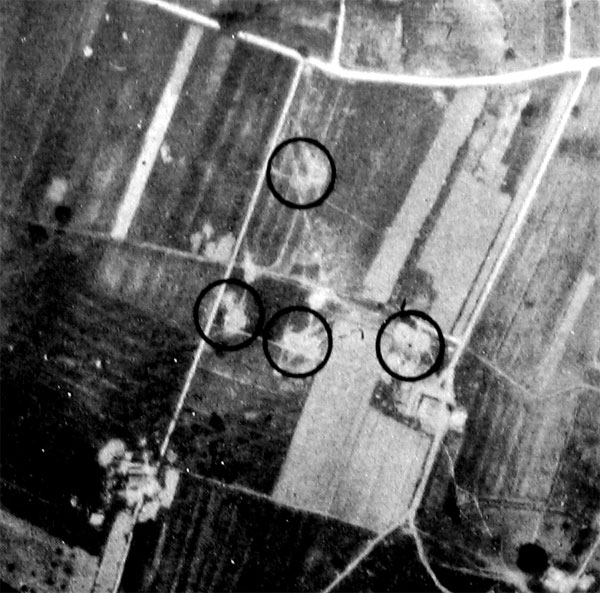
Example of a type of portion which Is impossible to interpret. Few vehicle tracks are vislble. Some activity around the house noted. Four very well camouflaged objects can be ieon but no definite statement con be made. It was reported as a dummy position.

The interpretation of a light gun, made on hazy photographs, is doubtful. The correct report should have been "suspected light gun," for one or two almost similar objects along the bend of the road could have been reported in the same way.

Position 410 is fairly clear; three guns are visible, particularly Nos. 1 and 3, which ore in rectangular emplacements. No. 2, in a circular emplacement, is less obvious. Position 42Q is not so well-defined, except for No. 2 gun. The presence of Nos. 1 and 3 is suggested only by the associated earthworks.
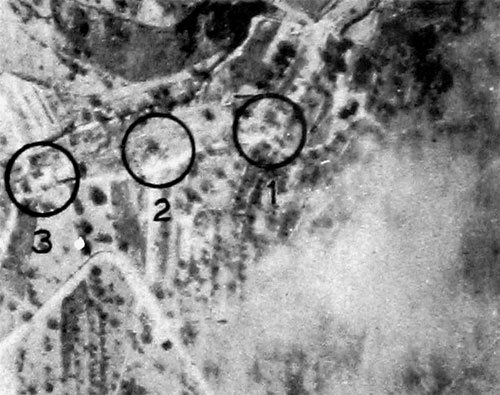
Emplacements 1 and 2 had been interpreted as field guns. No. 3 was not seen. The guns were camouflaged, and it was only the local activity and the clearly defined semicircular emplacement, plus the regular interval, which attracted attention. No. 1 gun was particularly well camouflaged under the trees.
TYPE 92 (1932) 70-MM HOWITZER

This is an infantry-support weapon.
Characteristics
Length (traveling position) .... 7 feet 3 inches
Length (firing position) ... 6 feet 7 inches
Height (firing position) .. 30.5 inches (top of
shield)
Length of tube ... 2 feet 6 inches
Weight ... 468 pounds
Maximum range ... 3,060 yards
Traverse ... 45 degrees
Elevation ... —10 to +70 degrees
Ammunition ... HE, AP, smoke
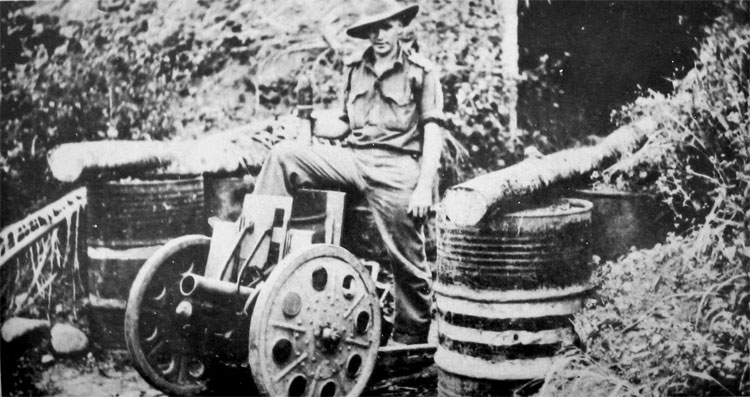
Ground photograph of Type 92 70-mm howitzer outiide a cave emplacement
TYPE 38 (1905) 75-MM FIELD GUN (IMPROVED)
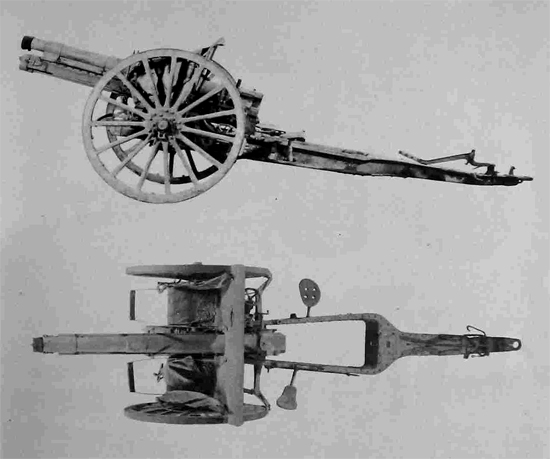
This is an improved version of the Type 38 (1905) 75mm gun, which appears to have been entirely replaced as a division artillery piece. The weapon is normally drawn by six horses.
Characteristics
Length (traveling position) ... 29 feet 4 inches
Length (firing position) ... 17 feet 2 inches
Height (firing position) ... 4 feet 11 inches
Type of trail ... Modified box
Length of tube ... 7 feet 6 inches
Weight ... 2,500 pounds
Maximum range ... 10400 yards
Traverse ... 7 degrees
Elevation ... —8 to +43 degrees
Ammunition ... HE, APHE, shrapnel, incendiary, illuminating, smoke
Method of transport ... Horse draft
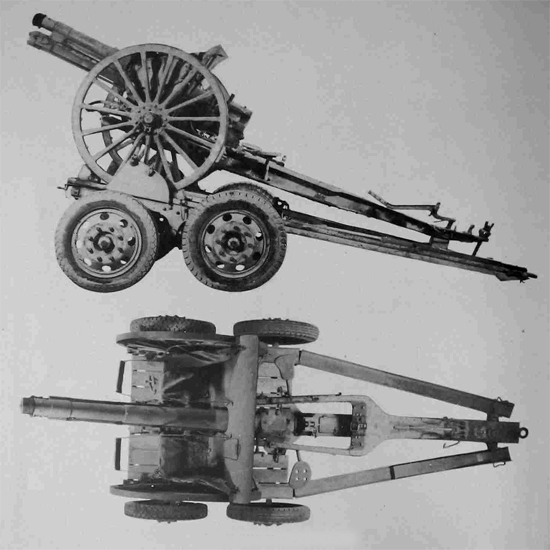
Type 38 (1905) 75-mm gun on trailer
TYPE 41 (1908) 75-MM REGIMENTAL GUN
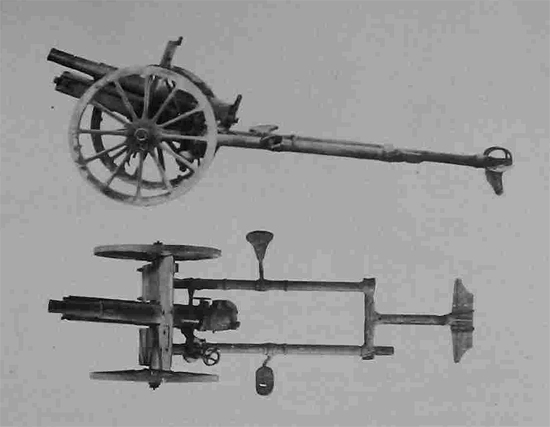
This weapon was originally the standard pack artillery weapon; but when it was largely superseded by the Type 94 (1934) 75-mm mountain pack gun it was issued for use as an infantry regimental gun.
Characteristics
Length (traveling position) ... 13 feet 4 inches
Length (firing position) ... 10 feet
Trails ... Box type
Weight ... 1,180 pounds
Maximum range ...7,000 yards
(with Type 94 HE)
Traverse ... 6 degrees
Elevation ... —18 to +40 degrees
Ammunition ... AP, HE, hollow charge, illuminating, shrapnel, incendiary, smoke
Method of transport ... Pack, May also be drawn
by one horse with rear portion of trail removed and shafts inserted.
TYPE 90 (1930) 75-MM FIELD GUN
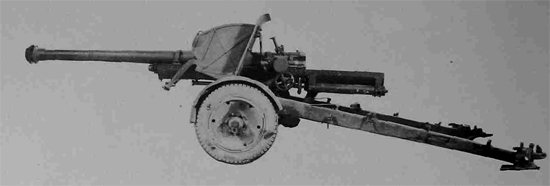
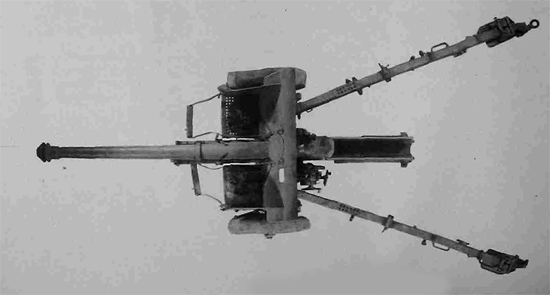
This gun is easily recognized by its long barrel and slotted muzzle brake. It is towed by a four-ton prime mover. Reports indicate this modern gun is the weapon of the motorized artillery regiment in the armored division and independent field artillery units.
Characteristics
Length (traveling position, horse-drawn with limber) ... 31 feet 8 inches
Length (firing position) ... 17 feet 2 inches
Height (firing position) ...5 feet 6 inches
Width of trail spread ...9 feet
Length of tube ... 8 feet 9 inches
Weight (horse-drawn version) ... 3,080 pounds
(mechanized version) ... 3,520 pounds
Maximum range ... 16,350 yards
Traverse ... 50 degrees
Elevation ... —8 to + 45 degrees
Ammunition ... HE, APHE, shrapnel, incendiary, smoke, pointed HE
TYPE 95 (1935) 75-MM GUN

This gun was designed by the Japanese to supersede the Type 38 (1905) 75-mm gun (improved) as a divisional artillery weapon.
Characteristics
Length (firing position) ... 15 feet
Length (traveling position) ... 29 feet 2 inches
Maximum range ... 11,66o yards
Elevation ... —8 to +43 degrees
Traverse ... 50 degrees
Maximum rate of fire 10 to 1 a rounds per
minute
TYPE 94 (1934) 75-MM MOUNTAIN (PACK) GUN
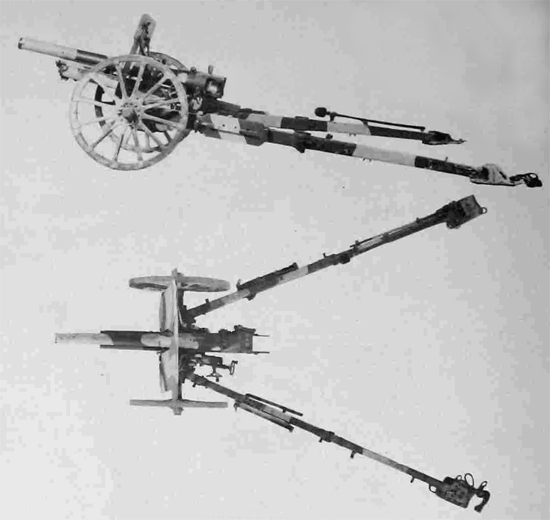
This is the standard Japanese pack artillery piece. The weapon is normally transported by
six pack horses. It has a comparatively long split trail.
Characteristics
Length (firing position) ... 11 feet 8 inches
Length (traveling position) ... 12 feet 6 inches
Barrel length ... 5 feet 1.5 inches
Weight in firing position ... 1,200 pounds
Maximum range ... 9,000 yards (with HE
pointed shell)
Elevation ... -9 to +45 degrees
Traverse ... 40 degrees
Maximum rate of fire ... 10 to 12 rounds per
minute
TYPE 14 (1925) 105-MM GUN
The 105-mm Type 14 (1925) gun is used for long-range fire. Mounted on wooden wheels, the weapon is normally tractor-drawn. As an alternative, it may be drawn by eight horses. It has a split trail.
Characteristics
Length (firing position) ... 21 feet 8 inches
Length (traveling position) ... 26 feet 8 inches
Tube length ... 11 feet 9 inches
Maximum range ... 14,500 to 16,500 yards
Elevation ... -5 to +43 degrees
Traverse ... 30 degrees
Maximum rate of fire ... 6 to 8 rounds per
minute
TYPE 91 (1931) 105-MM HOWITZER
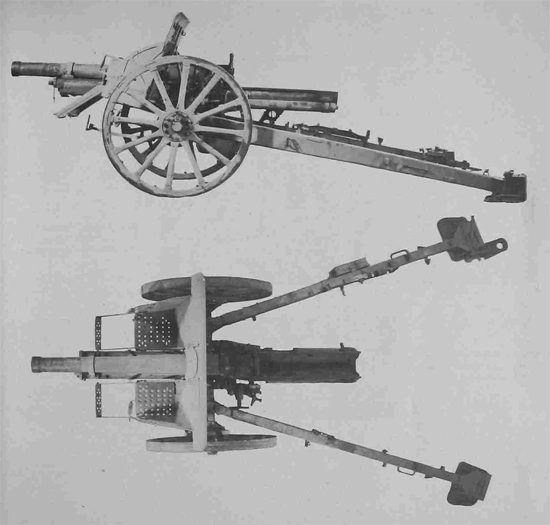
This howitzer, an organic weapon of division artillery units, is readily identified by its short tube and long cradle.
Characteristics
Length (traveling position) ... 29 feet 8 inches
Length (firing position) ... 15 feet 8 inches
Height (firing position) ... 5 feet 9 inches
Width of trail spread ... 6 feet
Length of tube ... 6 feet 11 inches
Weight ...3,300 pounds
Maximum range 11,500 yards (with HE
pointed shell)
Elevation ... —5 to +45 degrees
Traverse ... 40 degrees
Ammunition ... HE (long, pointed shell) , HE,
APHE, shrapnel, incendiary
Typical emplacement ... Open revetments approximately 10 feet
in diameter
Method of transport ... 6-ton Type 98 (1938)
prime mover or six
horses
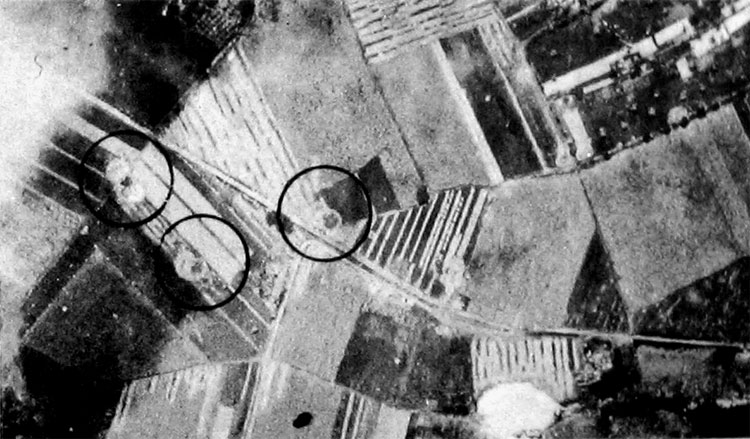
Scale 1:1,000. Photographs taken 18 April 1944 of three-gun Type 91 105-mm howitzer battery on Saipan

Scale 1: 10,000. Photographs taken 29 June 1944 of the same installation shown above.

Ground photograph of one of the gun in the position shown above after capture.
TYPE 92 (1932) 105-MM GUN
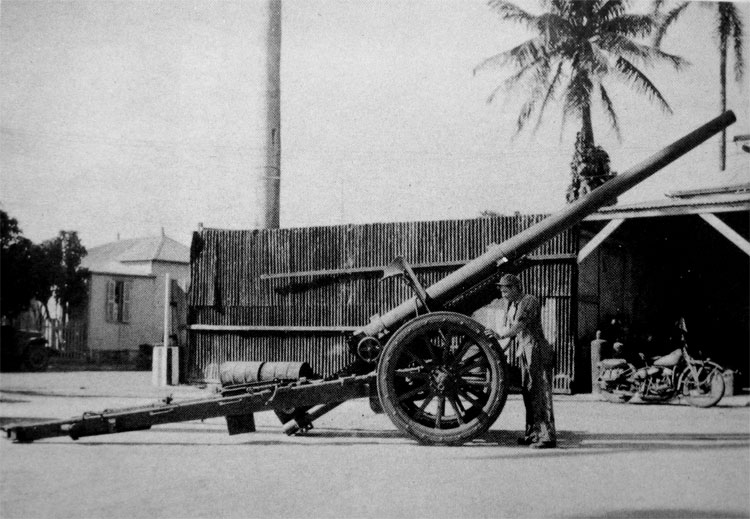
This gun is readily recognized by its long, slender barrel and trail. It is mounted on heavily constructed, wooden wheels with solid rubber tires. The weapon is normally tractor-drawn, but may be drawn by a 5-ton truck.
Characteristics
Length (firing position) ... 25 feet 10 inches
Length (traveling position) ... 32 feet 6 inches
Length of tube ... 15 feet 6 inches
Maximum range ... 20,000 yards
Elevation ... —5 to +45 degrees
Traverse ... 36 degrees
Maximum rate of fire ... 6 to 8 rounds per
minute
TYPE 89 (1929) 150-MM GUN
For transport the weapon is broken down into two loads. The barrel is loaded on one limber and the gun carriage on another. The Japanese niake use of caves as emplacements for this as well as other guns. Both caves and covered revetments are artfully camouflaged. Guns are
rolled from the cave to be fired and rolled back
again at the end of a mission.
Characteristics
Length (firing position) ... 29 feet 6 inches
Height (firing position) ... 3 feet 6 inches
Width of trail spread ... 7 feet 3 inches
Length of tube ... 20 feet
Maximum range ... 27,450 yards
Weight ... 23,000 pounds
Elevation ... -5 t0 +43 degrees
Traverse ... 40 degrees
Ammunition ... AP, HE, and shrapnel
Typical emplacement ... Caves and covered
positions
Method of transport ... Type 92A, 8-ton prime
mover

Scale 1:6,650. This stereo-pair shows two covered emplacements on Iwo Jima possibly for the Type 89 (1929) 150-mm gun. The deep-cut ruts indicate that the piece must have been a heavy caliber and had to be put into position by a heavy prime mover.
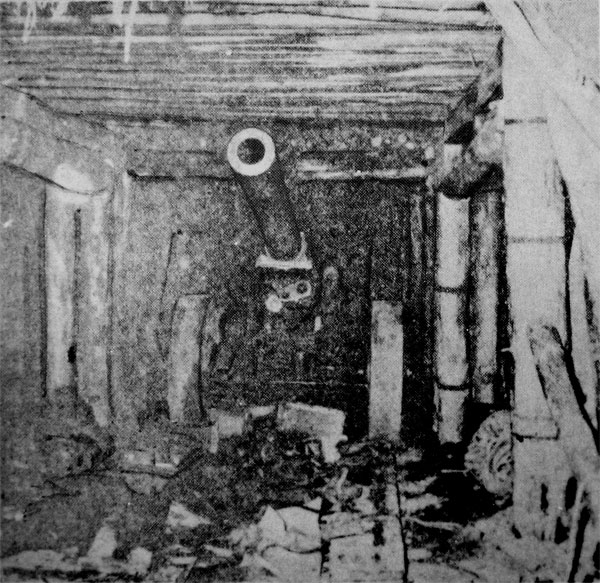
Front view of Type 89 (1929) 150-mm gun in cave position on Okinawa,
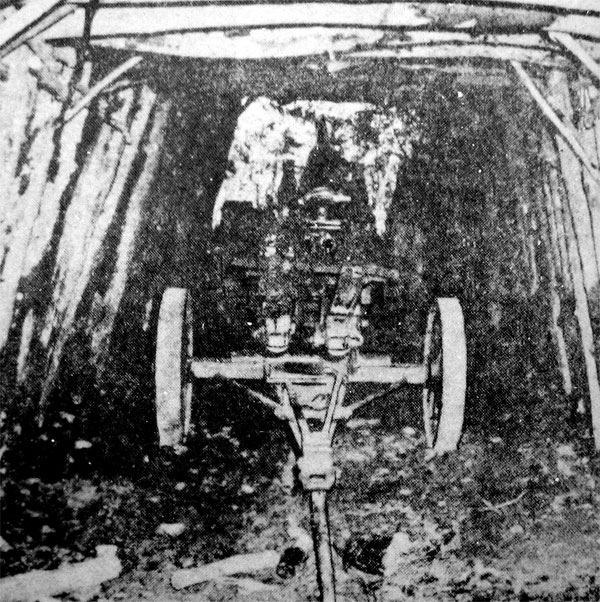
Rear view of same gurt. Note limber and lunette.

Type 92A prime mover used to transport the gun to the position.
TYPE 4 (1915) 150-MM HOWITZER
This is one of the older type, horse-drawn weapons. For transportation the trail breaks in the middle. The barrel is removed from the cradle and placed on the rear portion of the trail, to which an extra pair of wheels is attached. A limber is attached to each section and each load may be towed by six horses. The weapon has a box-type trail.
Characteristics
Length (firing position) ... 20 feet 10 inches
Length (traveling position) ... 27 feet 6 inches
Tube length ... 7 feet 3 inches
Maximum range ... 10,500 yards
Elevation ... —5 to +65 degrees
Traverse ... 6 degrees
Maximum rate of fire ... 3 to 4 rounds per
minute
TYPE 96 (1936) 150-MM HOWITZER
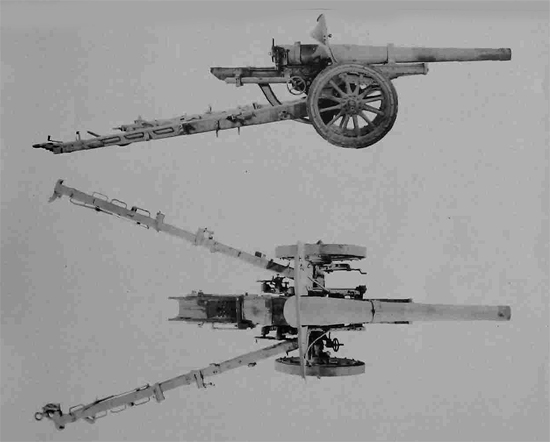
This weapon is the most modern of its type known to be possessed by the Japanese. The weapon cannot be fired at an elevation greater 45 degrees without the construction of a deep loading pit beneath the breech. The scale the vertical view of this howitzer (approximately 1:30) is slightly smaller than that of other vertical views in this section.
Characteristics
Length (traveling position) ... 32 feet 6 inches
Length (firing position) ... 22 feet
Height (firing position) ... 6 feet 7 inches
Length of tube ... 11 feet 6 inches
Weight ... 9,000 pounds
Maximum range ... 13,000 yards (with HE
pointed shell)
Elevation ... —5 to +65 degrees
Traverse ... 30 degrees
Ammunition ... Semi-fixed: APHE, shrapnel,
smoke, incendiary, tracer
Method of transport ... Type 92A prime mover

Ground photograph of Type 96 150-mm howitzer and caisson.
SECTION XII. ANTIAIRCRAFT ARTILLERY
Antiaircraft artillery batteries generally give the interpreter little difficulty because of their characteristic layout when emplaccd for firing. The heavy antiaircraft battery normally consists of four or more guns sited in a commanding position affording an all-round field of fire. It is not unusual to find six guns operating as a single battery. Of the Japanese heavy antiaircraft weapons, the 75-mm and 120-mm guns are the most common. They are normally placed in a regular pattern of four or six guns. The 76.2-mm gun has been found in batteries of three guns, while the 127-mm gun has so far been found in batteries of two twin mounts. The over-all length of gun barrels ranges from 10 feet 8 inches to 20 feet 7.5 inches. The revetments measure from 14 to 38 feet in inside diameter.
The command post is a prominent feature of the Japanese heavy antiaircraft emplacement. It is a multiple position, normally consisting of a number of different-size revetted positions grouped together in a single irregular mounded installation in which are located the various fire control mechanisms. In the simplest Japanese command posts, one multiple position contains separate compartments for the height finder, course and speed calculator, and observation binoculars. In more complex command posts a director, central telephone position, radar, or battery commander's post may be present.
Japanese medium and light antiaircraft guns or automatic weapons are frequently sit?d in batteries of three in the form of a triangle, although sometimes four or five emplacements are found together. Unlike German flak, the Japanese light antiaircraft emplacements are usually more openly spaced than heavy antiaircraft gun positions. The most common layout is in a shallow arc, but guns have been seen in square formations with four to six guns. There is no characteristic regular pattern for the layout of automatic weapons. The revetments are usually 8 to lfi feet in diameter, and the position may include one or two revetments for fire control instruments.
Antiaircraft artillery can be either static or mobile. The Japanese have made extensive use of naval guns statically emplaced in land positions for antiaircraft or dual-purpose roles-Japanese automatic weapons normally used [or antiaircraft purposes do not have the mobility generally characteristic of similar weapons in other armies. The 25-mm gun is the most effective and most used Japanese automatic weapon, but it is a naval weapon and has been given mobility on land only by placing it on improvised sled or trailer mounts. Automatic weapons are normally emplaced to supplement the protection given permanent sites where low-level air attacks may be expected and to give local protection to heavy-antiaircraft-gun batteries. It is also important to remember that certain types of antiaircraft can be given antitank missions.
Many of the weapons primarily designed for ground action and previously described under infantry armament are also used against aircraft. The 6.5-mm and 7.7-mm machine guns are relatively ineffective in an antiaircraft role-The 13.2-mm and 20-mm weapons are considerably more useful.
20-MM AUTOMATIC GUNS
The usual battery layout consists of four to six guns in a regular pattern similar to and adjacent to heavy antiaircraft batteries with one small, centrally controlled fire control revetment. Sometimes these weapons are laid out in batteries of two or three guns. The revetments have an inner diameter of 10 to 16 feet.
TYPE 98 (1938) 20-MM MACHINE CANNON
This Japanese Army gun is used as both an antiaircraft and an antitank weapon and is often emplaced in covered pillboxes when used in an antitank role. The Type 98 is gas operated. It is supported either on a two-wheel carriage or on three outriggers.
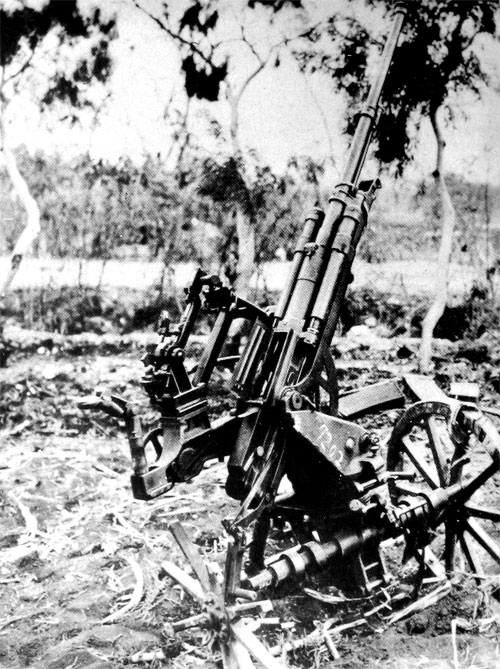
Type 98 (1938) 20-mm machine cannon in Kiska emplacement.
Characteristics
Length of barrel ... 57-25 inches
Maximum horizontal range ... 5,45o yards
Maximum vertical range ... 12,000 feet
Elevation ... —10 to +85 degrees
Traverse ... 360 degrees
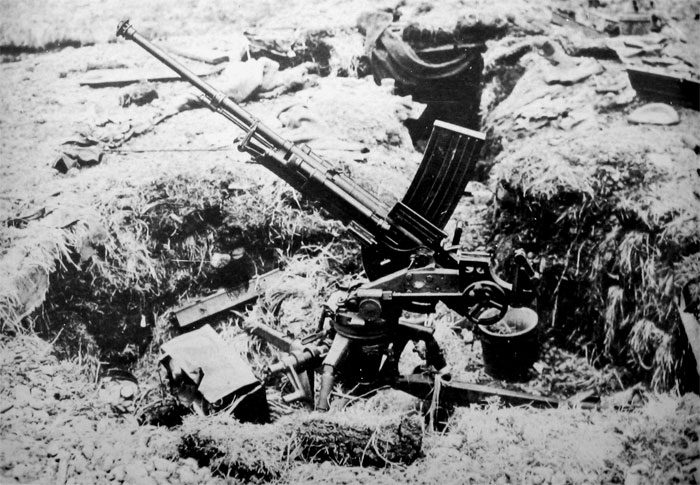
Type 98 20-mm machine cannon captured on Saipan.
20-MM OERLIKON (AIRCRAFT) MACHINE CANNON
Many times the Japanese have removed 20-mm machine cannon from disabled aircraft and used the weapons on the ground in an antiaircraft role. This is a recoil-operated gun, mounted on a pedestal as a rule, although some are found mounted in their original aircraft turrets.
Characteristics
Length over-all ... 64 inches
Length of barrel ... 30 inches
Effective range ... 600 yards
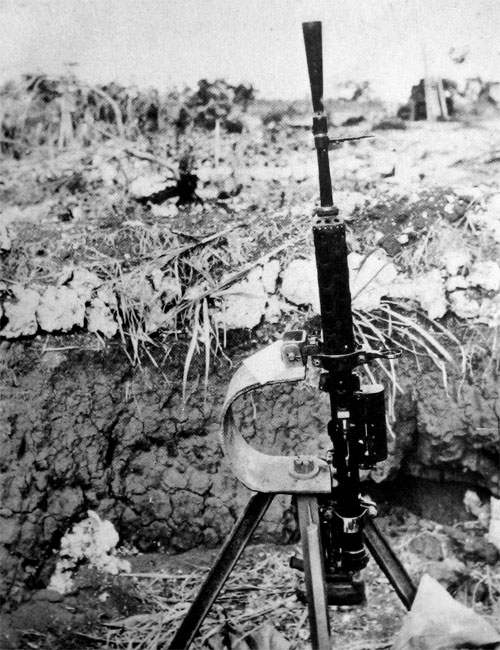
20-mm Oerfikon (aircraft) machine cannon on Tinian.
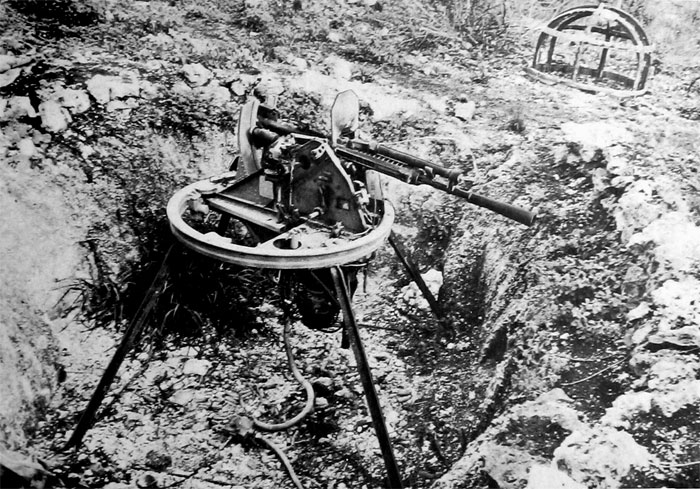
Note discorded airplane turret near this 20-mm Oerlikon machine-cannon position.
TYPE 96 (1936) 25-MM 5INGLE-MOUNT MACHINE CANNON
This gun is mounted on a platform which serves as the base for the pedestal mount.

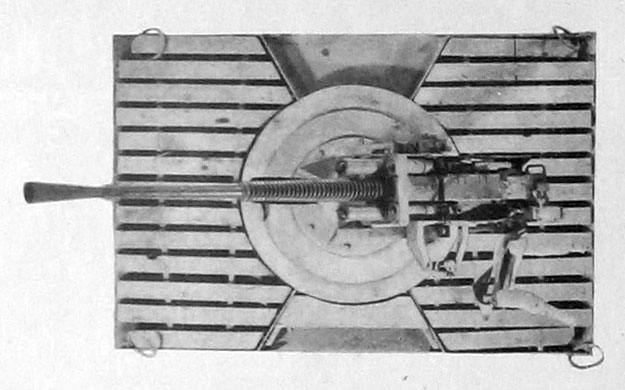
Characteristics
Length of barrel ... 59,25 inches
Maximum horizontal range ... 7,435 yards
Estimated maximum effective ... 4.500 feet
slant range
Elevation ... —10 to +85 degrees
Traverse ... 360 degrees
Type of mount ... Pedestal
Revetment: Size ... 8 to 10 feet. Shape ... Square or circular.
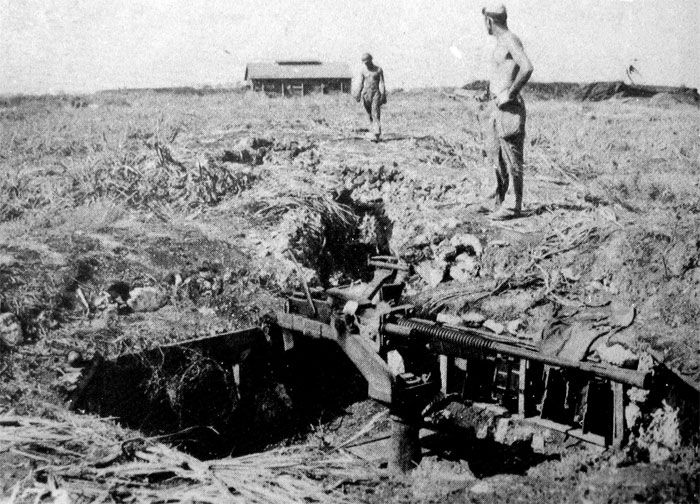
Ground photograph of single-mount 25-mm machine cannon on Saipon,
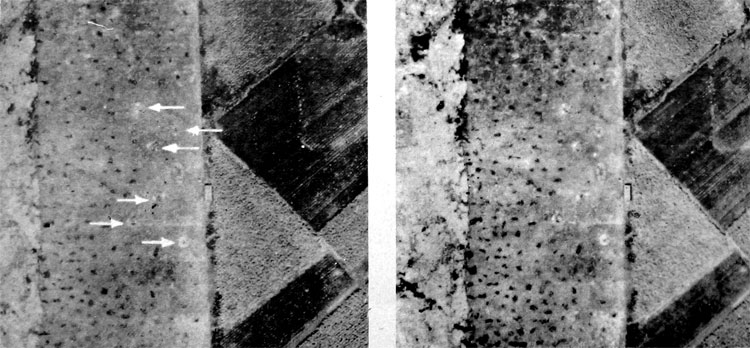
Scale 1:3,755, Automatic antiaircraft emplacements on 5aipan, possibly 25-mm gum.
TYPEB 96 (1936) 25-MM TWIN-MOUNT MACHINE CANNON
This gun was made lor naval service, but is used on land against aircraft and tanks.
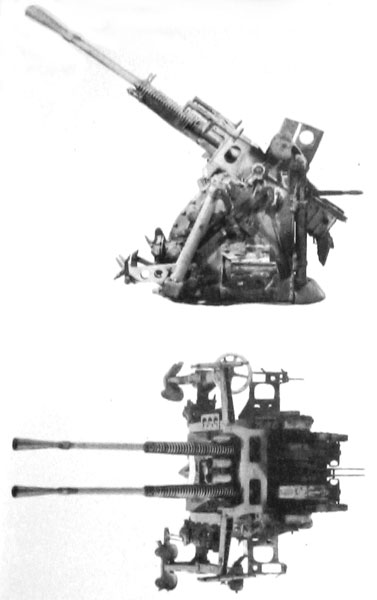
Characteristics
Length of barrel ... 59.i25 inches
Maximum horizontal range ... 7,435 yards
Maximum effective slant range ... 4,500 feet
Elevation ... —10 to +85 degrees
Traverse ... 360 degrees
Revetment: Size ... 10 to 12 feet.
Shape ... Circular
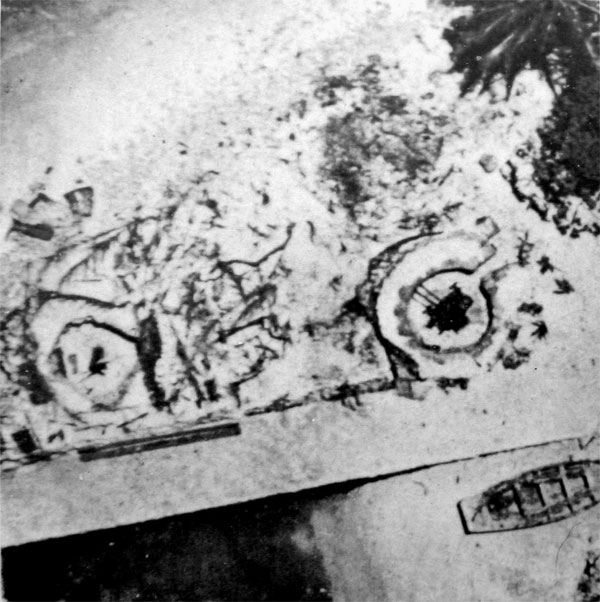
Scale 1:1,000, Twln-mounf 25mm machine canoon end 13.2-mm
machine gun of Truk.

Scale 1,6.650. Four twin-mount and one triple-mount 25-mm
machine cannon on Iwo Jima.
EXAMPLES OF THE DIFFICULT PROBLEM OF AUTOMATIC-WEAPONS INTERPRETATION

Scale 1: 10,000, Saipan. Japanese 25-mm machine-cannon revetments measuring 10 to 12 feet in diameter.
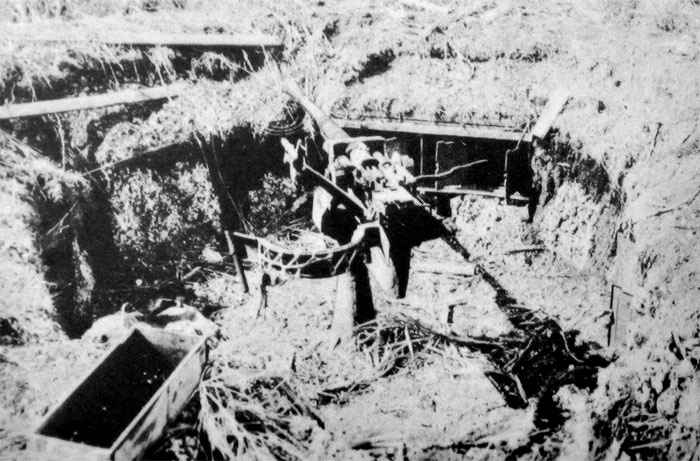
The ground photograph shows one of the guns after capture.


Two photos above show Japanese single- end twin-mount 25-mm machine cannon in Saipon revetments measuring 8 to 10 feet in diameter.
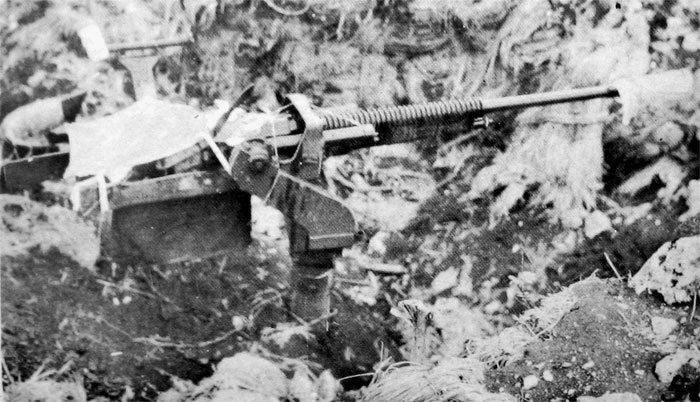
Ground photograph of the single-mount gun

Ground photograph of the twin-mount weapon.
CAPTURED 25-MM SINGLE- AND TWIN-MOUNT MACHINE CANNON
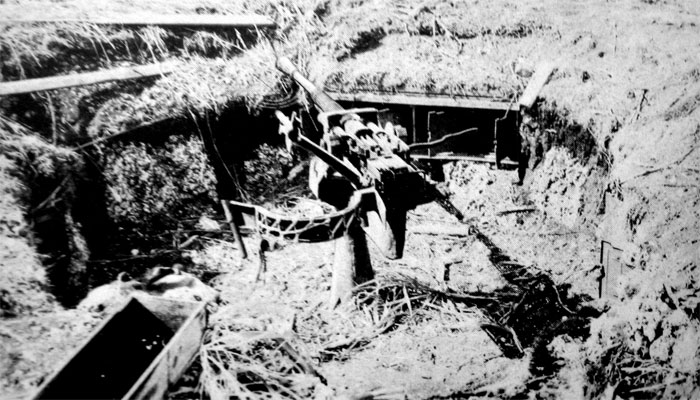
Guam

Saipan
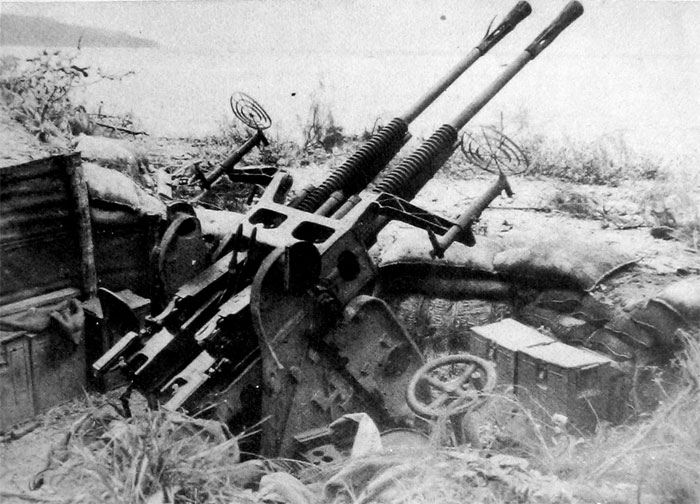
Tinian

Two 25-mm single-mount and one 25-mm twin-mount cannon in a Japanese emplacement on Guam. Operators on the left side of the single mounts are visible.
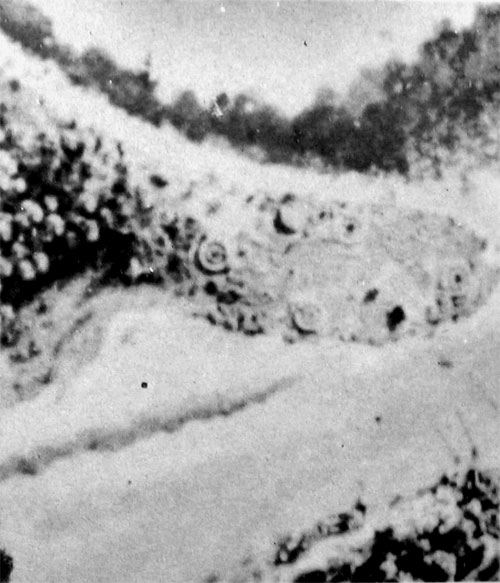
Twin-mount 25-mm machine cannon at Kavieng, Misa Island.
TYPE 96 (1936) 25-MM TRIPLE-MOUNT MACHINE CANNON
This air-cooled gun was made for naval service, but it is used on land against aircraft and tanks. It has a high muzzle velocity and is probably Japan's most important medium caliber gun, although its heavy pedestal mount limits its adaptability to ground emplacement. It has been encountered in single-, twin-, and triple-mount versions.

Characteristics
Estimated maximum effective slant
range ... 4.500 feet
Elevation ... 85 degrees
Traverse ... 360 degrees
Type of mount ... Fixed pedestal
Revetment: Diameter 12 to 16 feet.
Shape ... Circular, may be
double-walled
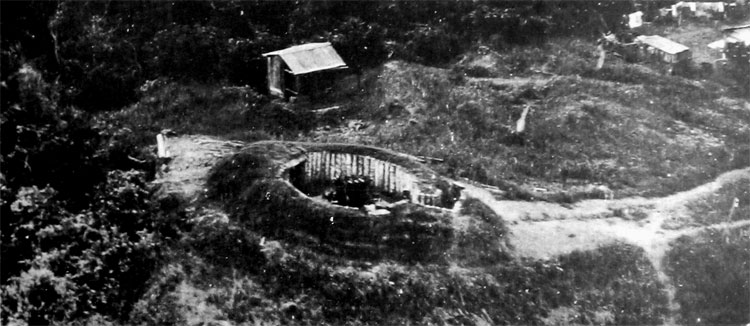
Triple-Mount 25-mm machine cannon at Rabaul, New Britain.
TYPE 96 (1936) MOBILE 25-MM MACHINE CANNON
The single-barrel version of the 25-mm weapon has been found on a two-wheel mobile mount. Also, the Japanese have mounted the twin-barrel Naval 25-mm gun on a trailer to secure mobility. The pedestal is not used and the gun is bolted directly to the floor of the trailer, which is a four-wheel type with dual rear wheels. It is solidly constructed and seems capable of movement over difficult terrain. The 25-mm weapon has been placed on sleds in some cases as another form of improvised mobile mount.
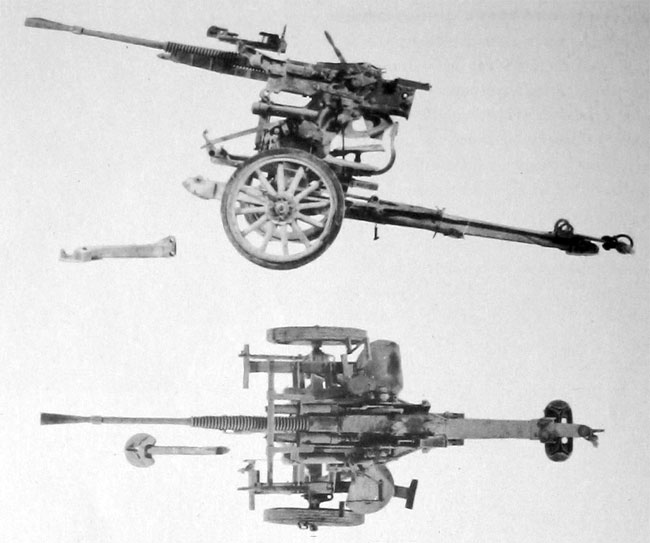
Characteristics of improvised trailer mount
Length of trailer ... 12 feet 8 inches
Width of trailer ... 6 feet 11 inches
Height of trailer bed ... 3 feet 7 inches
Length of towing bar ... 6 feet 3 inches
Revetment: Size ... 8 by 14 feet.
Shape ... Rectangular
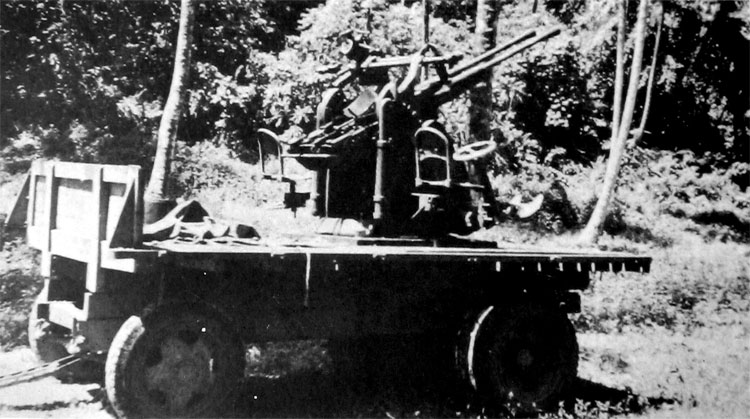
This trailer-mounted 25-mm gun was captured during tho invasion of the Admiralties.

Scale 1:6,650, two Jima. Emplacements for the machine cannon on its improvised trailer mount will appear on photographs to be very similar to revetments for vehicles, except that the weapon must be so located as to afford a field of fire. Revetments marked (1) in the verticals above ore typical of the type that may be constructed for this mobile 25-mm gun.
40-MM SINGLE- AND TWIN-MOUNT ANTIAIRCRAFT MACHINE CANNON
This weapon is a Vickers-type recoil-opera ted, water-cooled, link-belt-fed, automatic or semiautomatic machine cannon. Single-mount guns, captured from the British early in the war, were copied by the Japanese.
Characteristics
Length of barrel ... 5 feet 2 inches
Maximum horizontal range ... 7,000 yards
Maximum effective slant range ... 3,600 feet
Elevation ... —5 to +85 degrees .
Traverse .... 360 degrees
Battery layout ... Two- and three-gun batteries in
irregular patterns are used as primary
defense units.
Revetments ... 10 to 16 feet in diameter Single
and double-walled.
Fire controI ... .A revetment is sometimes provided for an officer with binoculars. A ran finder to determine initial ranges would be useful with this weapon and may be encountered.
Mount ... Fixed pedestal.
It should be noted that considerable numbers of the British 40-mm Bofors gun fell into the hands of the Japanese. These weapons are similar in appearance to the 40-mm Bofors used by the U. S.
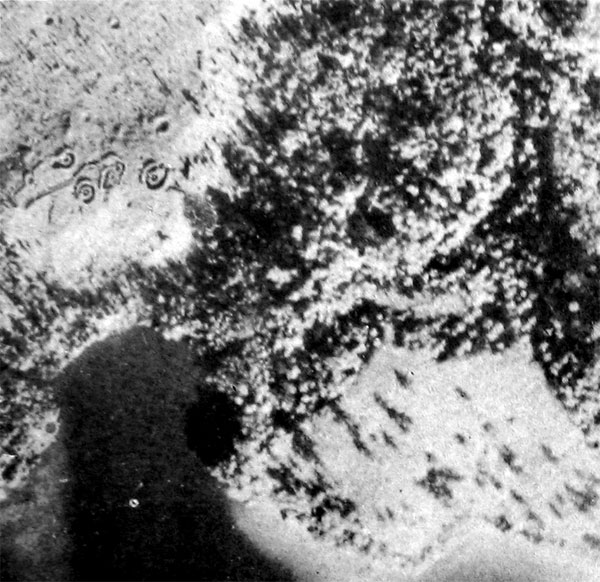
Two twin-mount 40-mm and two twin-mount 73.2-mm guns at Kolombangara.

An oblique of the position shown in the stereo-pair obove
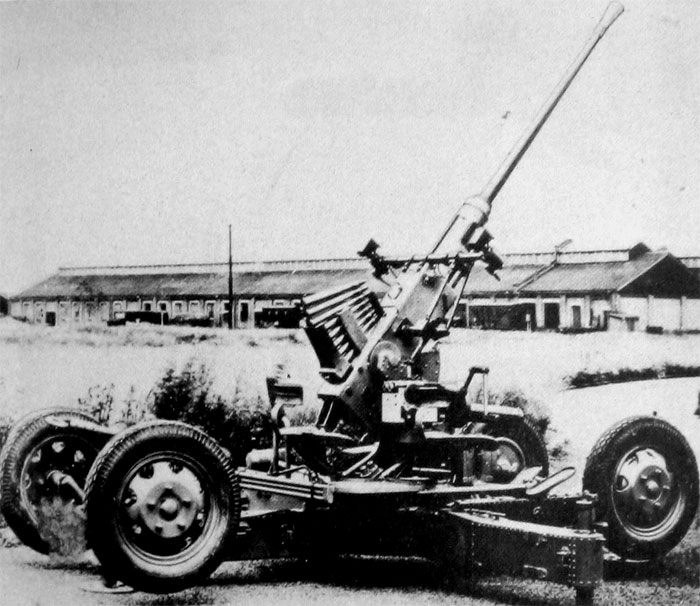
40-mm Bofors automatic cannon.

40-mm Bofors in position.
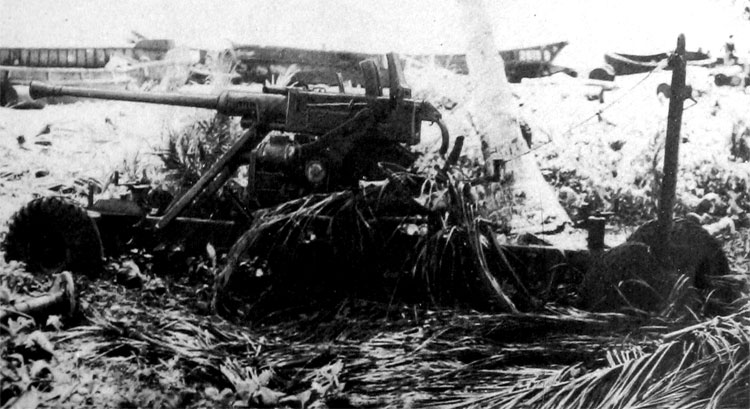
Japanese position for British 40-mm Bofors on Luzon.
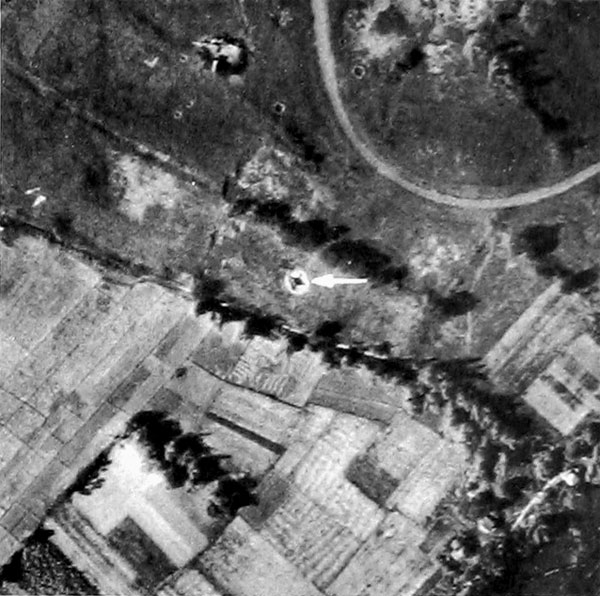
40-mm automatic cannon in a Japanese emplacement at Kolombongoro.
TYPE 88 (1928) 75-MM ANTIAIRCRAFT GUN
This gun is a mobile antiaircraft piece designed for quick emplacement.


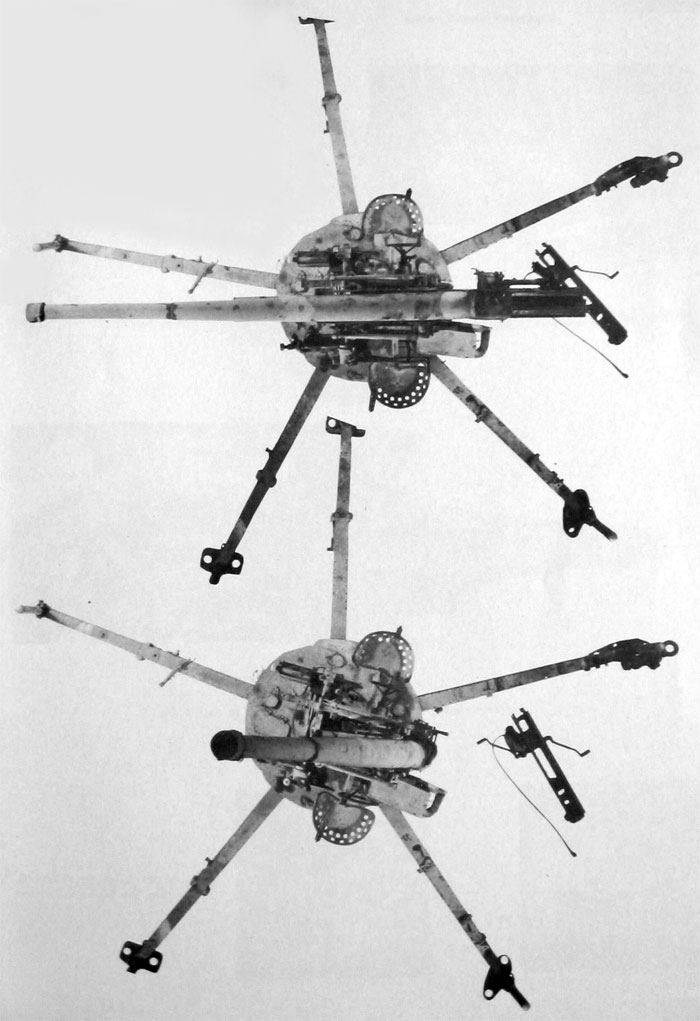
Characteristics
Length of tube ... 10 feet 10 inches
Type of mount ... Mobile, two wheels with
five outriggers
Maximum range: Horizontal ... 15,080 yards.
Vertical ...29,500 feet
Elevation ... —7 to +85 degrees
Traverse ... 360 degrees
Revetment: Diameter ... 15 to 20 feet.
Shape ... Circular or pentagonal

Ground photograph of a Type 88 (1928) 75-mm antiaircraft-gun emplacement.

Low altitude oblique.
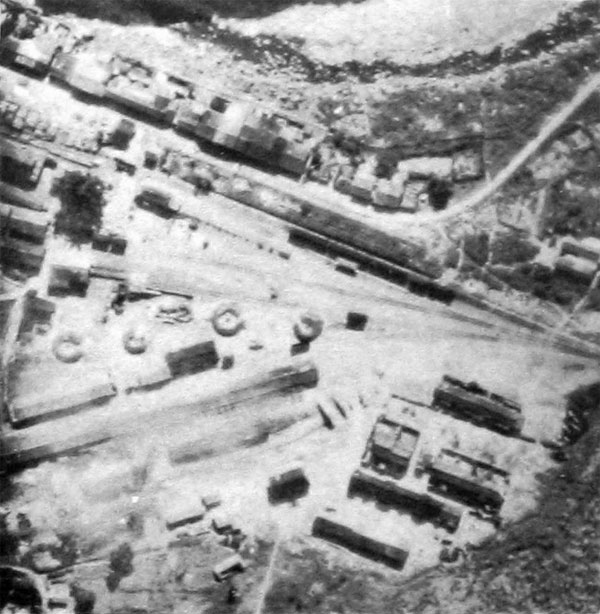
Scale 1:4,000. Stereo-pair of Type 88 (1928) 75-mm gun battery on Formosa.

Type 88 (1928) 75-mm antiaircraft gun in traveling position.
FIRE CONTROL INSTRUMENTS
These instruments are found with 75-mm antiaircraft batteries, usually in separate positions within the battery layout as part of the command post.
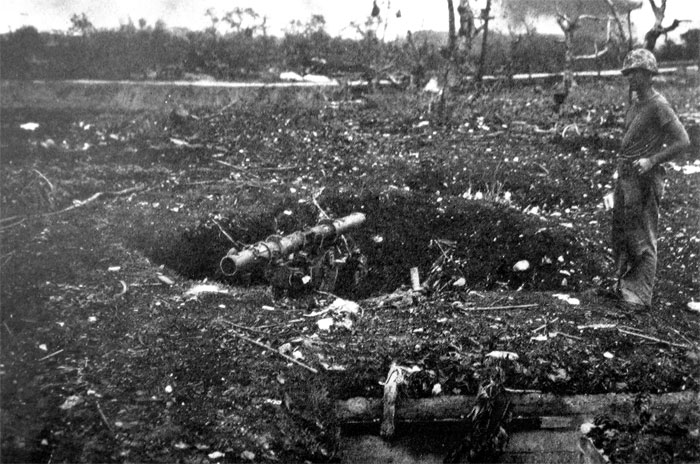
Height and range finder.
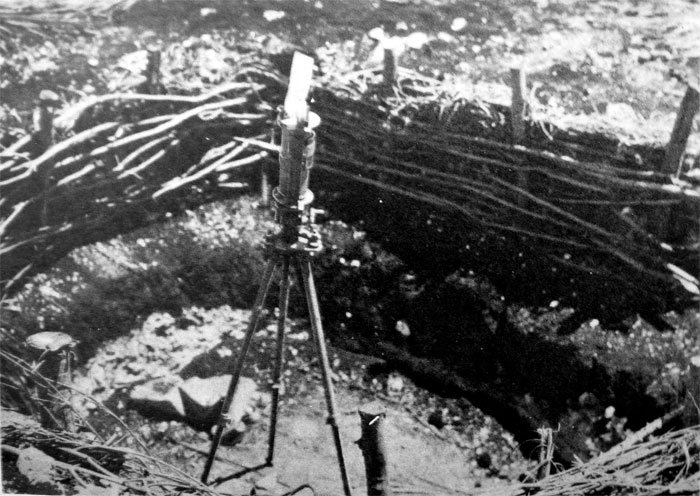
Target-speed and course-angle calculator.
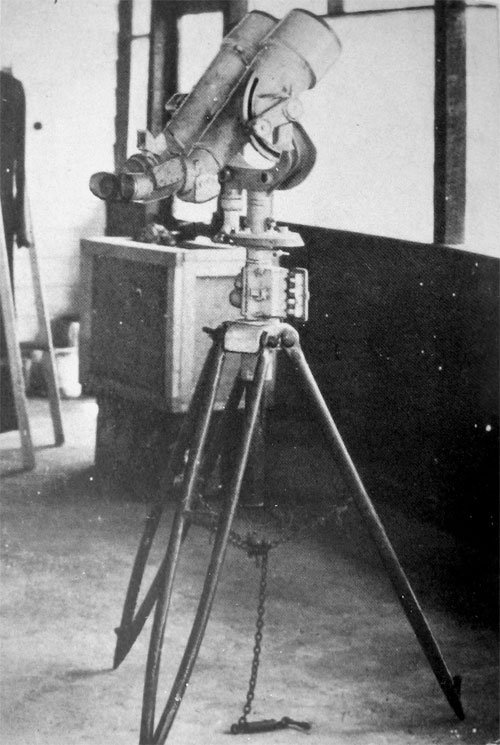
Antiaircraft fire control binoculars.

A five-gun 75-mm antiaircraft battery and command post.
Important aspects of Japanese emplacements for antiaircraft Suns may be missed in a study of photographs unless interpreters are familiar with the weapons, with all aspects of antiaircraft defenses, and with the capabilities of antiaircraft guns in antitank and coast defense roles.

Scale 1:5,000. A six-gun 75-mm battery and command post. The revetments for the guns are 18 to 20 feet, inside diameter. Note the light antiaircraft artillery position.

Typical examples of Japanese 75-mm antiaircraft positions are shown on this and the following page.
Note the command post in this Kiska position.
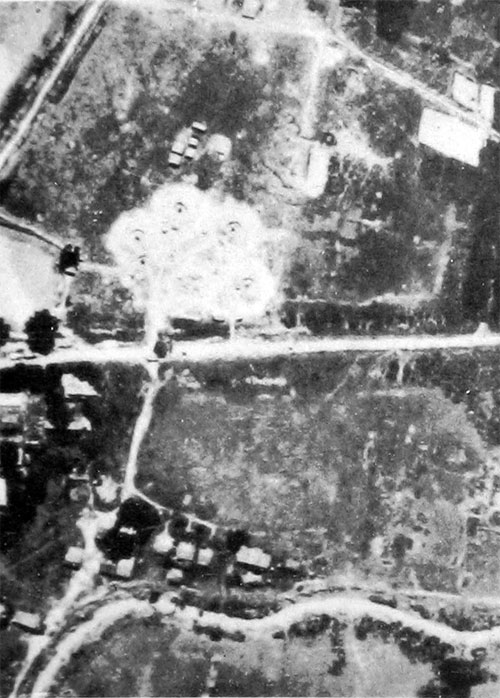
Emplacement in Burma.
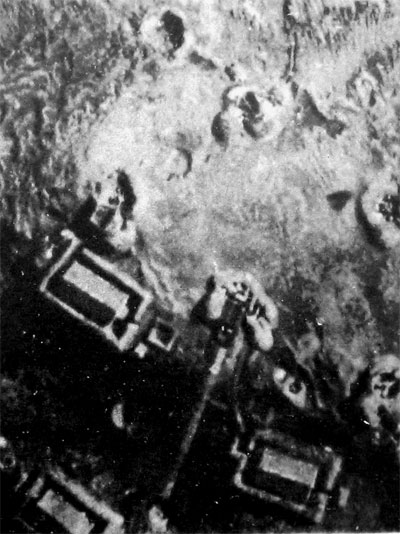
Emplacement on Kiska.

Antiaircraft guns at Boram.
TYPE 3 (1914) 76.2-MM DUAL-PURPOSE GUN
This is a naval dual-purpose piece which has been placed on a pedestal mount. A noticeable feature is the unusually long recoil cylinder on top of the tube.


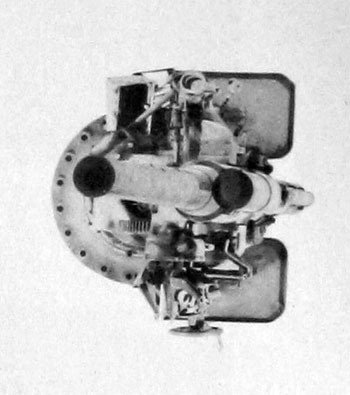
Characteristics
Length of tube ... 9 feet 6 inches
Maximum vertical range ... 24,000 feet
Elevation ... —5 to +75 degrees
Maximum traverse ... 360 degrees
Rate of fire ... 10 to 12 rounds per minute
Battery layout ... Similar to 75-mm batteries. Often found in batteries of three.
Revetments ... Similar to 75-mm batteries; however, the inner diameter varies from 14 to 20 feet.
Fire control ... Height finder and data computer arc necessary for controlled fire. However, this gun may be used only for barrage fire, in which case only the height finder would be necessary.
Mount ... Fixed pedestal; no outriggers.
Type 3 (1914) 76.2-mm dual-purpose gun ct maximum elevation.
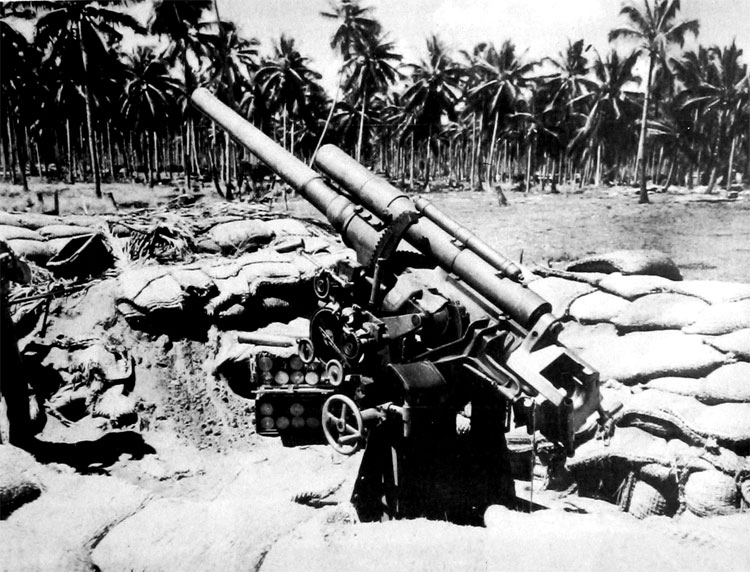
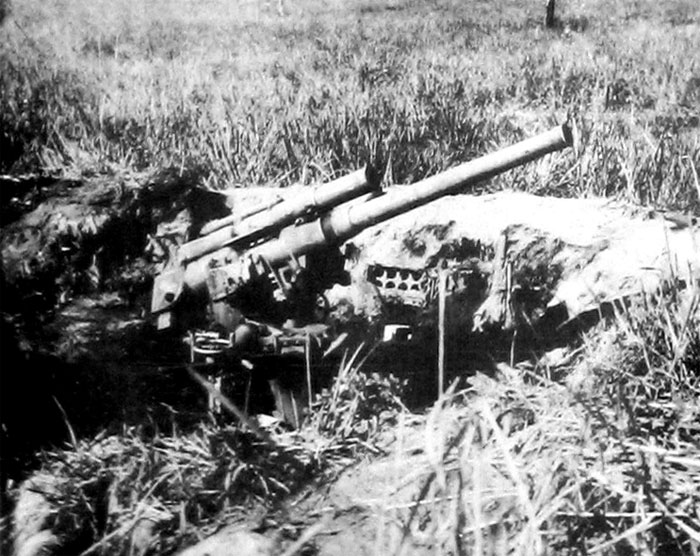

76,2-mm dual-purpose guns in positions, captured on Guadalcanal
TYPE 98 (1938) 100-MM DUAL-PURPOSE GUN
This twin-mount, dual-purpose naval gun has capabilities believed to exceed those of other Japanese antiaircraft guns so far encountered, A 4-meter range finder was captured at the battery command post where this weapon was taken, but no director was in evidence.
Characteristics
Length of tube ... 20 feet 7.5 inches
Maximum vertical range ... 44,000 feet
Maximum horizontal range ... 20,400 yards
Traverse ... 360 degrees
Rate of fire ... 15 rounds per minute
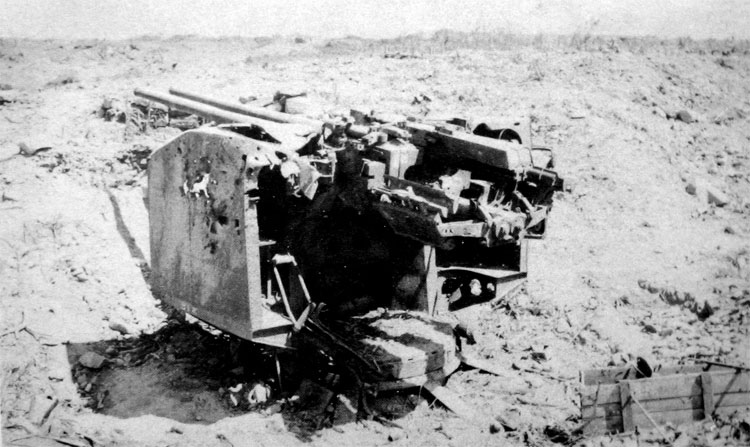
Ground photograph of 100-mm
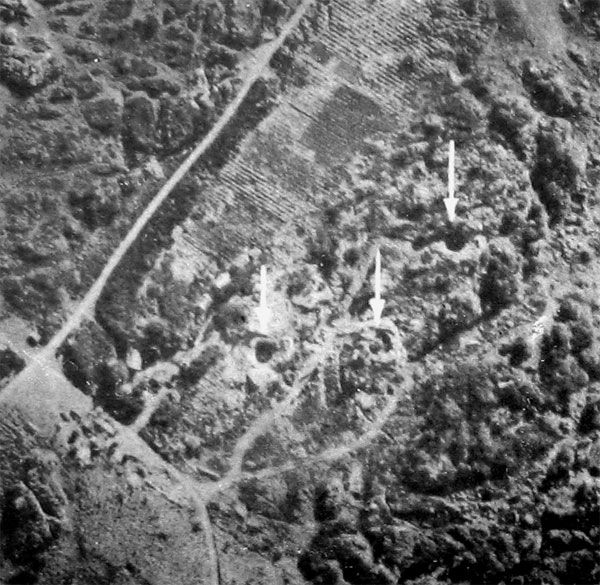
Scale 1:6,650, Iwo Jima. 100-mm gum have boen reported horo, and the two stereo-palr reveal gun positlons under construction
TYPE 14 (1925) 105-MM ANTIAIRCRAFT GUN
This is the heaviest mobile Japanese antiair-craft weapon in use at present. It has a pedestal mount, and in firing position the wheels are detached and the gun rests on six outriggers.
Characteristics
Length of barrel .... 13 feet 9 inches
Maximum vertical range ... 30,000 feet
Maximum horizontal range ... 16,500 yards
Elevation ... 0 to 85 degrees
Traverse ... 360 degrees
Battery layout ... Two-, four-, and six-gun batteries in a regular pattern similar to the battery layout for Type 88 75-mm guns.
Revetments .... 23 to 25 feet inner diameter.
Fire control ... The same as used with Type 88 75-mm guns.
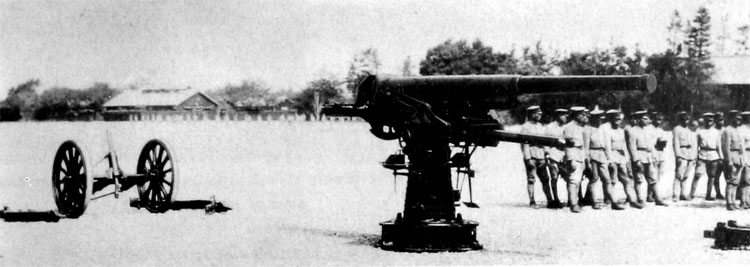
Type 14 (1925) 105-mm gun, outriggers removed,

105-mm antiaircraft gun at Hamamatsu, Honshu

The gun in traveling position.

The gun being put in firing position. Note the six outriggers.
TYPE 10 (1931) 120-MM DUAL-PURPOSE GUN
The shield of this naval gun is seldom used when the weapon is placed in a shore position-Some of the guns captured were in covered emplacements where they were used for coastal defense only. This gun is particularly adaptable to a dual-purpose role and has become the Japanese principal heavy antiaircraft gun.
Characteristics
Length of tube ... 17 feet 7.5 inches
Maximum range ... 17.500 yards
Elevation ... —5 to +75 degrees
Maximum traverse ... 360 degrees
Battery layout ... One- to six-gun batteries in regular heavy antiaircraft and artillery patterns. When used in covered emplacements for coast defense, the batteries consist of one or two guns.
Revetments ... 21 to 28 feet inner diameter. Covered emplacements are usually constructed of reinforced concrete.
Fire control ... Two types of fire control:
TYPE I
2-meter or 3-meter base range finder or possibl 4.5-meter base range finder.
Director.
Electrical transmission cables.
Binoculars.
TYPE II
Height and range finder.
Course and speed calculator.
Binoculars.
Mount ... Fixed pedestal mount with a large base plate or spade buried in the floor of each gun pit.
Shield ... The shield is roughly square (approximately 9 by 10 feet) with a sliding canopy to the left of the barrel which may be opened. The left side of the shield is rounded.
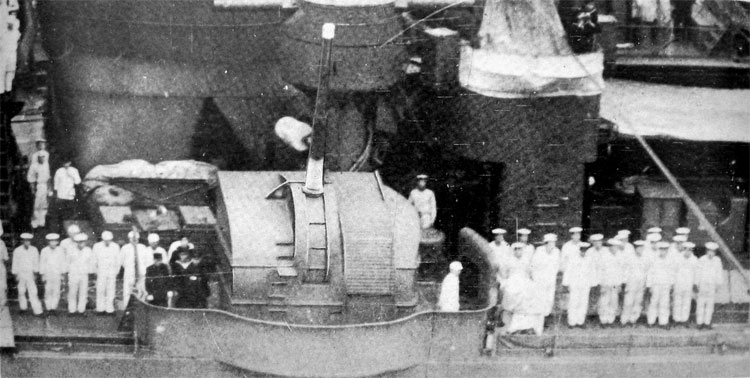
120-mm gun aboard ship. Note range finder at top of photo.
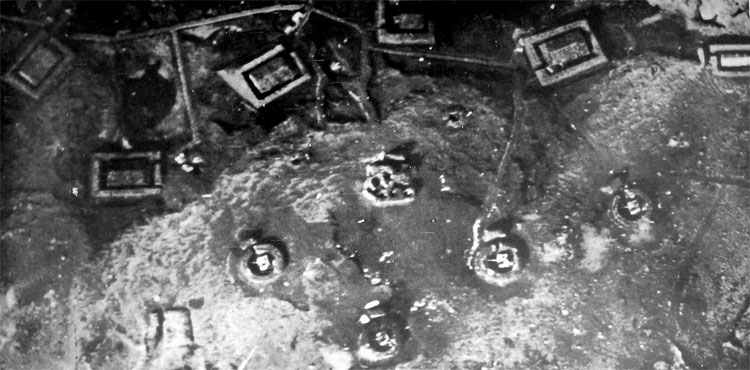
120-mm gun in antiaircraft position on Kiska.

Scale 1:1,125 120-mm antiaircraft gun battery poiltlon captured on Kiska.

120-mm gun battery.

A ground photograph of a 120-mm flun after capture at Salpan In a position similar to those plctured above and below.
Frequently it will be difficult to establish the caliber of antiaircraft weapons located on aerial photographs because of the identical size of the 75-nim and 120-mm gun emplacements. However, on a large-scale photograph of good definition, it will be noted that the barrel of the 120-mm gun protrudes over the rim of the revetment. In any case where the caliber of the gun is doubtful, it should be reported as a heavy antiaircraft gun.
120-MM GUN POSITIONS
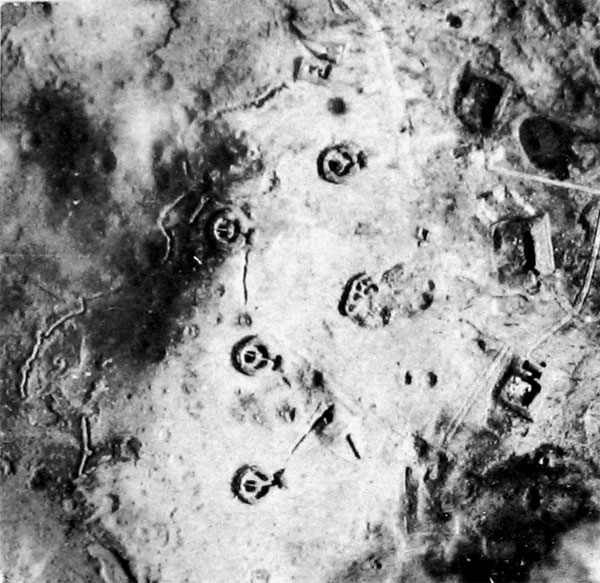
120-mm battery with all prominent characteristics.

Photo Scale 1:3,000
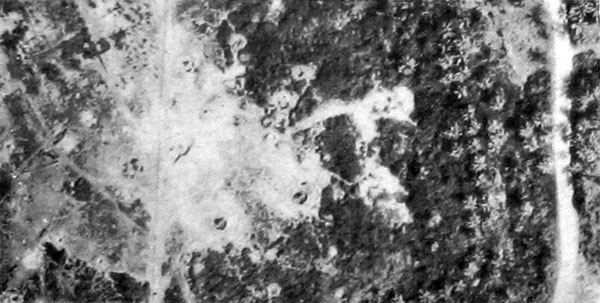
Scale 1:5,000 (approximately). Revetments measure about 20 feet in diameter.

Scale 1:10,000 (approximately).

Scale 1:10,000 (approximately)
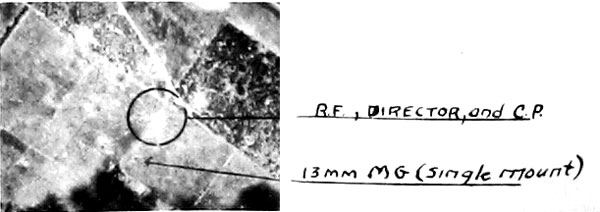
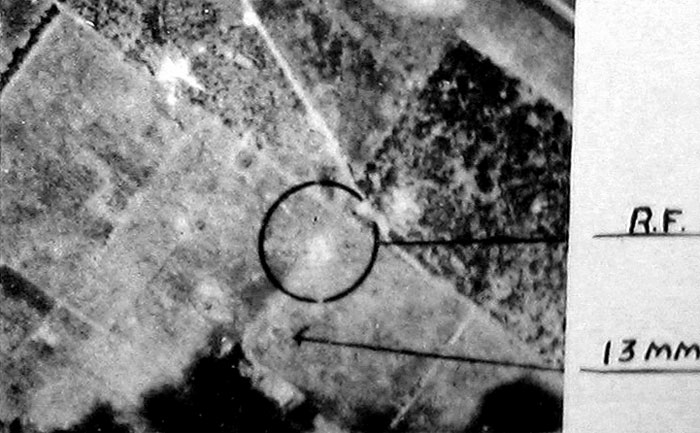
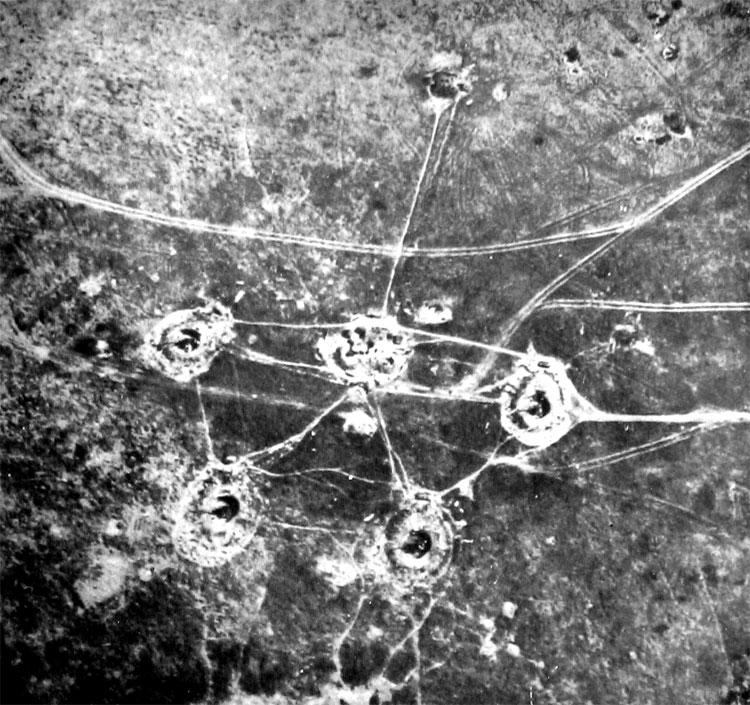
120-mm battery on Mindanao lsland, Philippines. The fire control used at this antiaircraft gun position is revealed by the cable trenches
from the command post to each gun.

Note the wooden spider of this 120-mm gun which is usually buried in the floor of the gun position and is seldom visible on photographs.

120-mm gun positions on Truk. Scale 1; 1,000 (approximately).

120-mm gun posftions on Kiska. Scale 1:2,390 (approximately).

120-mm gun captured on Saipon.
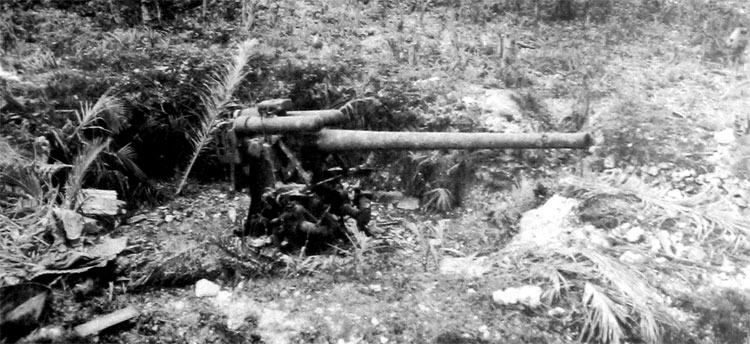
Type 10 (1921) 120-mm gun in position on Peleliu.
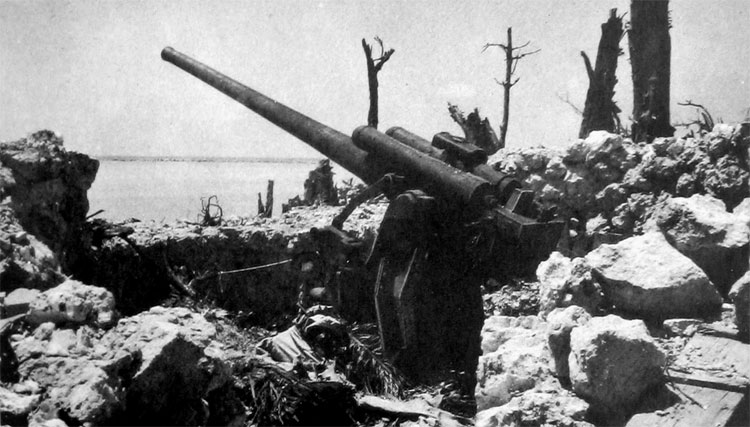
Type 10 (1921) 120-mm gun captured at Peleliu.
TYPE 89 (1929) 127-MM DUAL-PURPOSE GUN
This twin-barrel naval gun is usually mounted aboard-ship, but it has frequently been found in Japanese shore installations. When found ashore, it is easily identified by its battery layout and shield.
Characteristics
Length of tube .... 16 feet 7 inches
Effective vertical range ... 24,300 feet
Horizontal range ... 15400 yards
Rate of fire for each barrel ...
12 to 15 rounds per minute
Battery layout ... Two guns have been found in all batteries. The most common layout consists of three similar revetments in a shallow arc with the center revetment empty- The center revetment may be quite small and contain a light weapon, or there may be only two revetments, both occupied.
Revetments ... 33 to 38 feet inner diameter; constructed of concrete with 4 to 12 readv ammunition lockers set in the walls.
Fire control ... Located at equal distances from the guns on the roof of a revetted building (approximately 35 by 33 feet), A 4.5-meter base range finder is located on a circular platform 14 feet in diameter on the rear of the building. Binoculars are also found on the fire control building The ground floor of the building may house electrical equipment. One 150-cm searchlight is usually found on each flank of the battery.
Mount ... Fixed pedestal mount, electrically operated.
Shield ... Approximately 15 by 4 feet. The shape of the shield is distinctive. This gun has not been observed without the shield.
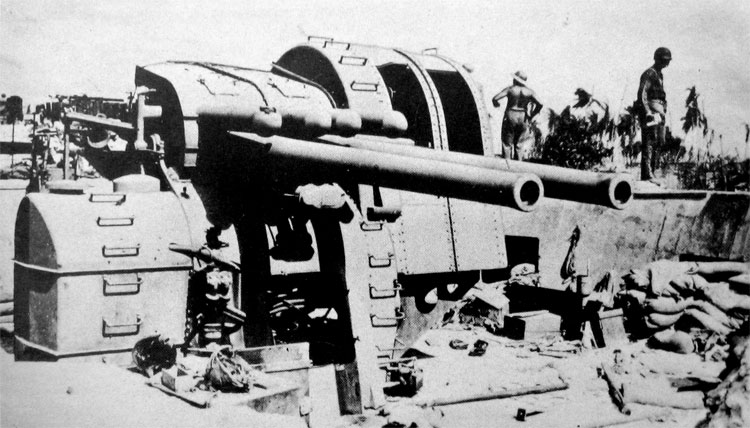
127-mm dual-purpose weapon captured on Tarawa.

127-mm gun positions on Mille Island.
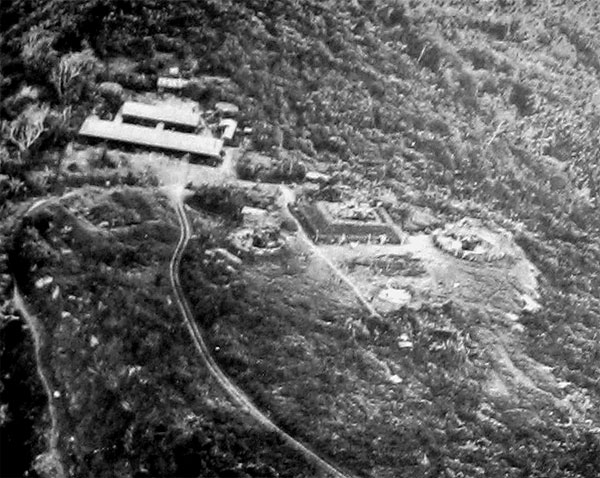
An oblique stereo-pair of a 127-mm battery
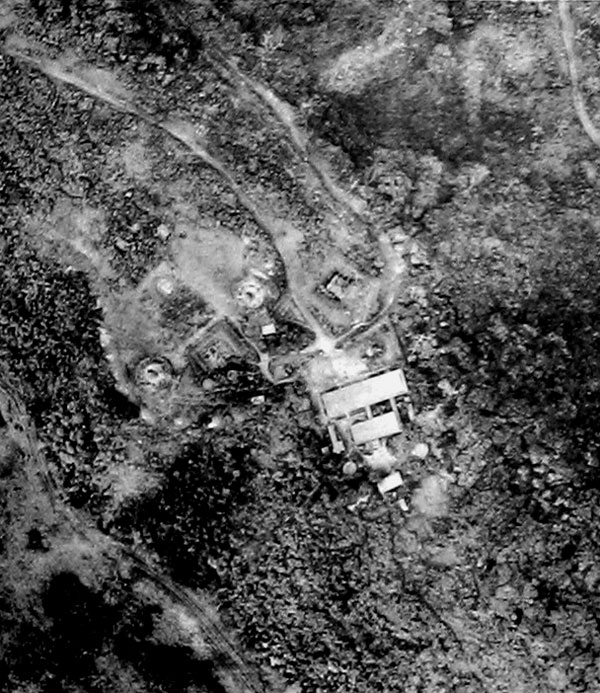
A vertical stereo-pair of the same battery.

127-mm gun emplacements on Okinawa. Note the ammunition bays.
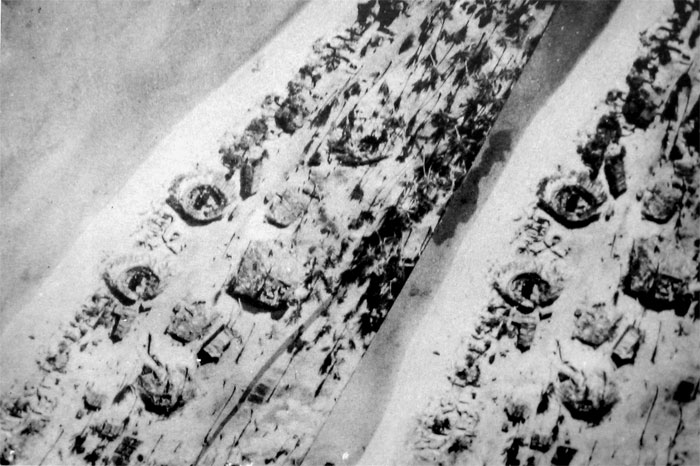
127-mm gum on Tarawa
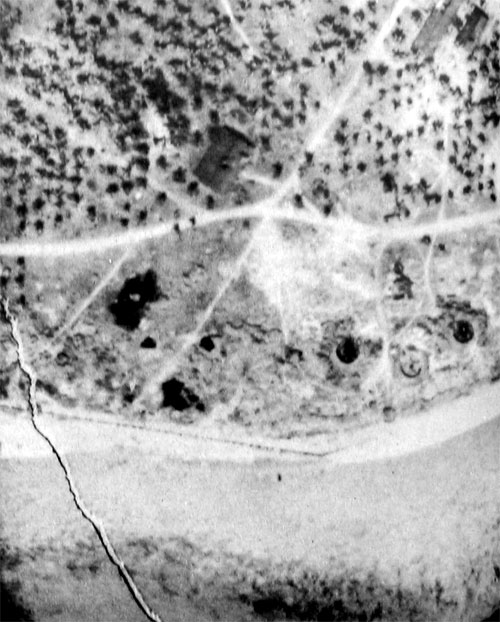
Scale 1:4,750. Powible 127-mm gun at Wotje.
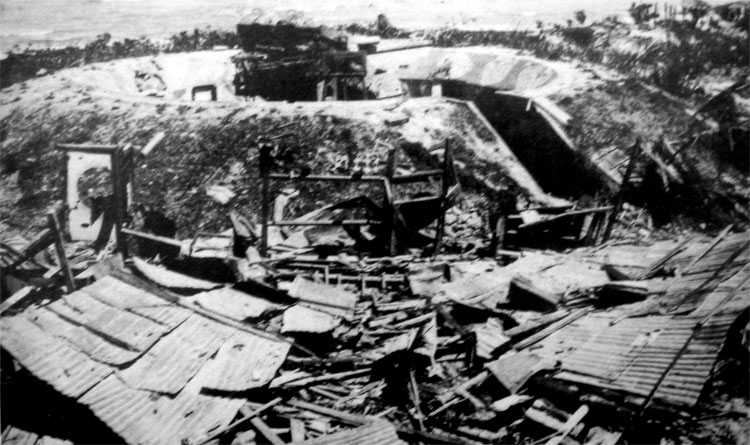
Namur Island 127-mm positlon.
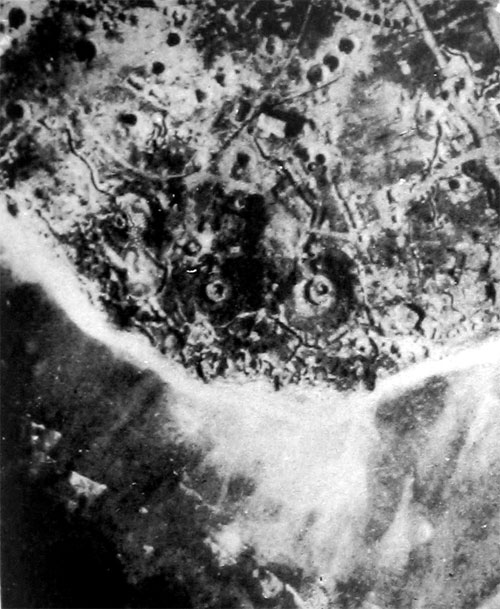
Scale 1:4,160. 127-mm guns at Jaluit.
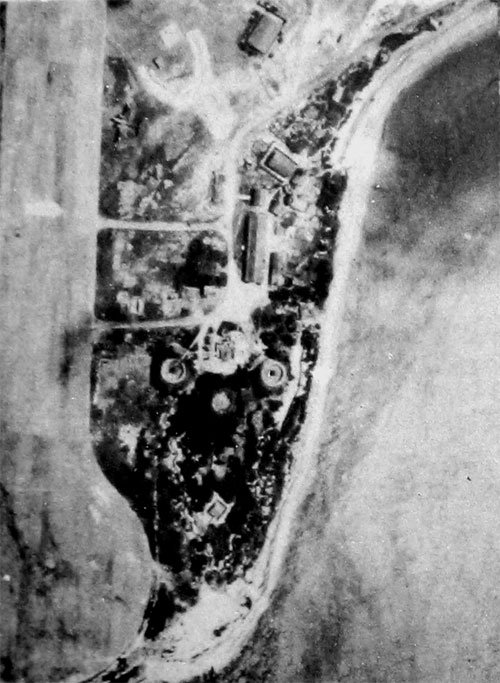
Scale 1: 6,550. Probable 127-mm battery on Kwajalein
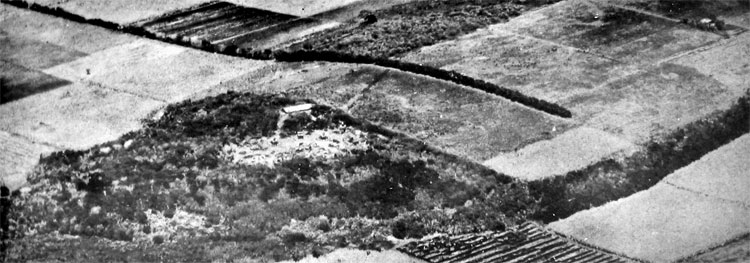
127-mm dummy position on Saipan. The position shown in this oblique photograph is obviously a dummy because of the lack of track activity and the shallow revetments. This is a typical example of Japanese dummy positions.
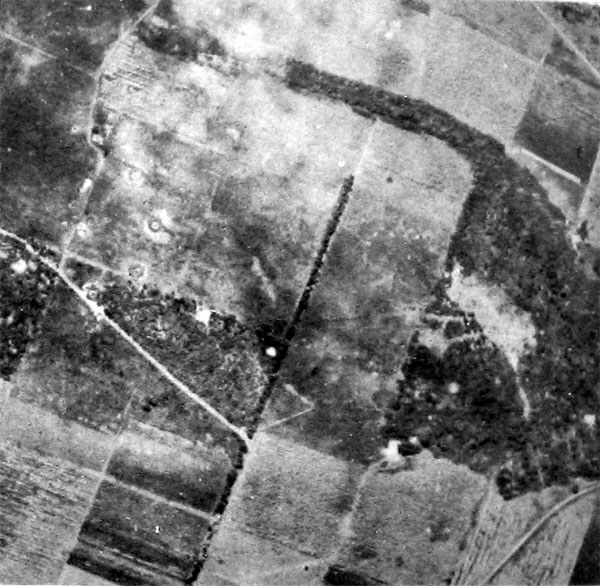
Later a heavy antiaircraft battery was moved into the field in the upper right of the above picture and it can be easily picked out in the vertical photographs.
See also: